Pentair Pool Spa Heaters NT User Manual
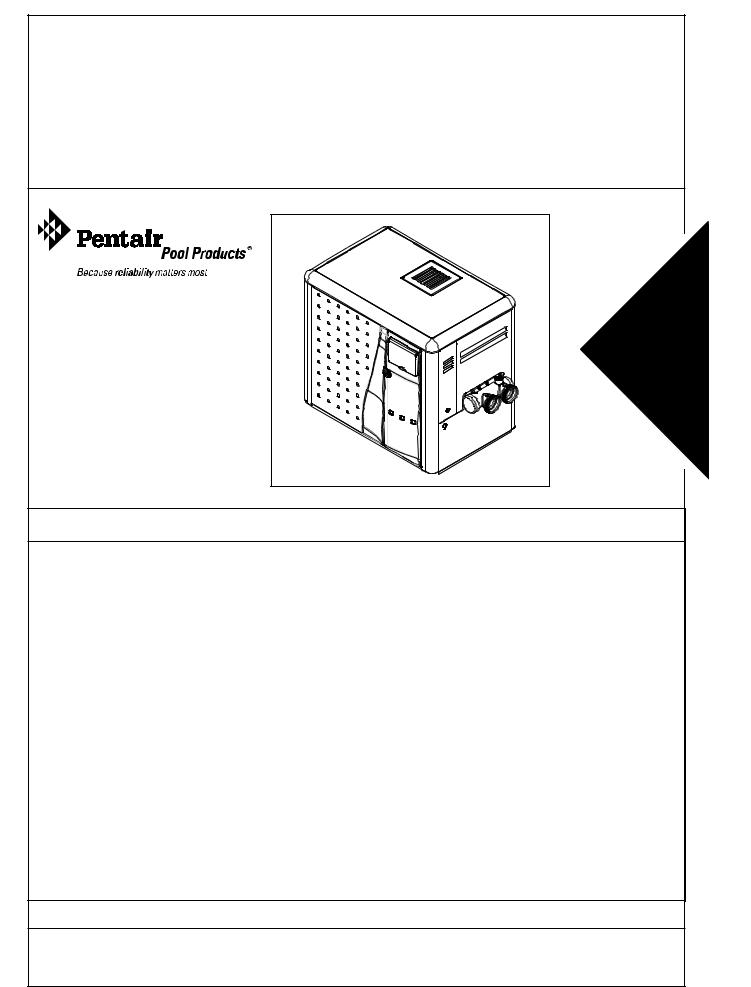
1 1
MiniMax NT® Series
Pool & Spa Heaters
OPERATION & INSTALLATION MANUAL
To
Consumer
Retain For
Future
Reference
U.S. Patent Numbers 6,295,980 5,318,007 - 5,228,618 5,201,307 - 4,595,825
WARNING
FOR YOUR SAFETY - READ BEFORE OPERATING
•If you do not follow these instructions exactly, a fire or explosion may result, causing property damage, personal injury or loss of life.
•Improper installation, adjustment, alteration, service or maintenance can cause property damage, personal injury or death. Installation and service must be performed by a qualified installer, service agency or the gas supplier.
•Do not store or use gasoline or other flammable vapors and liquids in the vicinity of this heater or other appliances.
WHAT TO DO IF YOU SMELL GAS
•Do not try to light any appliance.
•Do not touch any electrical switch; do not use any phone in your building.
•Immediately call your gas supplier from a neighbor's phone. Follow the gas supplier's instructions.
•If you cannot reach your gas supplier, call the fire department.
For additional free copies of this manual; call (800) 831-7133.
Pentair Water Pool and Spa, Inc.
1620 Hawkins Ave., Sanford, NC 27330 • (919) 566-8000
10951 W. Los Angeles Ave., Moorpark, CA 93021 • (805) 523-2400
Rev. E 4-15-05 |
P/N 472235 |
2
Customer Service
If you have questions about ordering Pentair Pool Products replacement parts, and pool products, please use the following contact information.
Customer Service (8 A.M. to 5 P.M. Pacific Time)
Phone: (800) 831-7133 (press 3 in voice mail)
Fax: (800) 284-4151
Technical Support for Pentair Pool Products
Sanford, North Carolina (8 A.M. to 5 P.M. Eastern Time)
Phone: (919) 566-8000
Fax: (919) 566-8920
Moorpark, California (8 A.M. to 5 P.M. Pacific Time)
Phone: (805) 523-2400 (Ext. 6502)
Fax: (805) 530-0194
Web site
visit www.pentairpool.com to find information about Pentair Water Pool and Spa, Inc.
© 2004 Pentair Water Pool and Spa, Inc.
1620 Hawkins Ave., Sanford, NC 27330 • (919) 556-8000
10951 West Los Angeles Ave., Moorpark, CA 93021 • (805) 523-2400
All rights reserved. Information in this document is subject to change without notice.
Trademarks and Disclaimers. MiniMax NT and the Pentair Pool Products logo are registered trademarks of Pentair
Water Pool and Spa, Inc. Other trademarks and trade names may be used in this document to refer to either the entities claiming the marks and names or their products. Pentair Water Pool and Spa, Inc. disclaims any proprietary interest in trademarks and trade names other than its own.
P/N 472235 |
Rev. E 4-15-05 |
|
3 |
Table of Contents |
|
Section I. Heater Identification Information ........................................................... |
4 |
Section II. Introduction ............................................................................................ |
5 |
Important Notices ...................................................................................................................................................................... |
5 |
Warranty Information ................................................................................................................................................................. |
5 |
Code Requirements ................................................................................................................................................................... |
6 |
Consumer Information and Safety ............................................................................................................................................. |
6 |
Section III. Installation .............................................................................................. |
7 |
Specifications ............................................................................................................................................................................ |
7 |
Plumbing Connections ............................................................................................................................................................... |
8 |
Valves ........................................................................................................................................................................................ |
8 |
Manual By-Pass ........................................................................................................................................................................ |
8 |
Below Pool Installation .............................................................................................................................................................. |
8 |
Water Connections .................................................................................................................................................................... |
9 - 10 |
Gas Connections ....................................................................................................................................................................... |
11 |
Sediment Traps ......................................................................................................................................................................... |
11 |
Gas Pipe Sizing ......................................................................................................................................................................... |
12 |
Testing Gas Pressure/Gas Pressure Requirements .................................................................................................................. |
13 |
Indoor Venting—General Requirements .................................................................................................................................... |
14 |
Indoor (USA) / Outdoor (Canada) Installations .......................................................................................................................... |
15 |
Combustion Air Supply .............................................................................................................................................................. |
16 |
Vent Adaptors ............................................................................................................................................................................ |
16 |
Indoor Installations —Venting Guidelines .................................................................................................................................. |
17 |
Outdoor Installations —Venting Guidelines ............................................................................................................................... |
18 |
Outdoor Vent Kit ........................................................................................................................................................................ |
18 |
Electrical Connections ............................................................................................................................................................... |
19 |
Wiring Diagram—NT STD & TSI with DDTC ............................................................................................................................. |
20 |
Section IV. Operation ................................................................................................ |
21 |
Basic System Operation ............................................................................................................................................................ |
21 |
HSI (Hot-Surface Ignition) Lighting/Operation ........................................................................................................................... |
21 |
Safety Controls .......................................................................................................................................................................... |
22 - 23 |
Digital Display Temperature Controller (DDTC) ......................................................................................................................... |
24 - 28 |
Section V. Troubleshooting ....................................................................................... |
28 |
Troubleshooting (DDTC) ............................................................................................................................................................ |
28 |
Troubleshooting (General) ......................................................................................................................................................... |
29 |
Service Checks - Ignition Module .............................................................................................................................................. |
29 |
Section VI. Maintenance ......................................................................................................... |
30 |
Maintenance Instructions ........................................................................................................................................................... |
30 |
Pressure Relief Valve ................................................................................................................................................................ |
30 |
Energy Saving Tips .................................................................................................................................................................... |
30 |
Spring, Fall and Winter Operation ............................................................................................................................................. |
31 |
Chemical Balance ...................................................................................................................................................................... |
32 |
Replacement Parts — NT STD& TSI w/DDTC .......................................................................................................................... |
33 - 37 |
Rev. E 4-15-05 |
P/N 472235 |
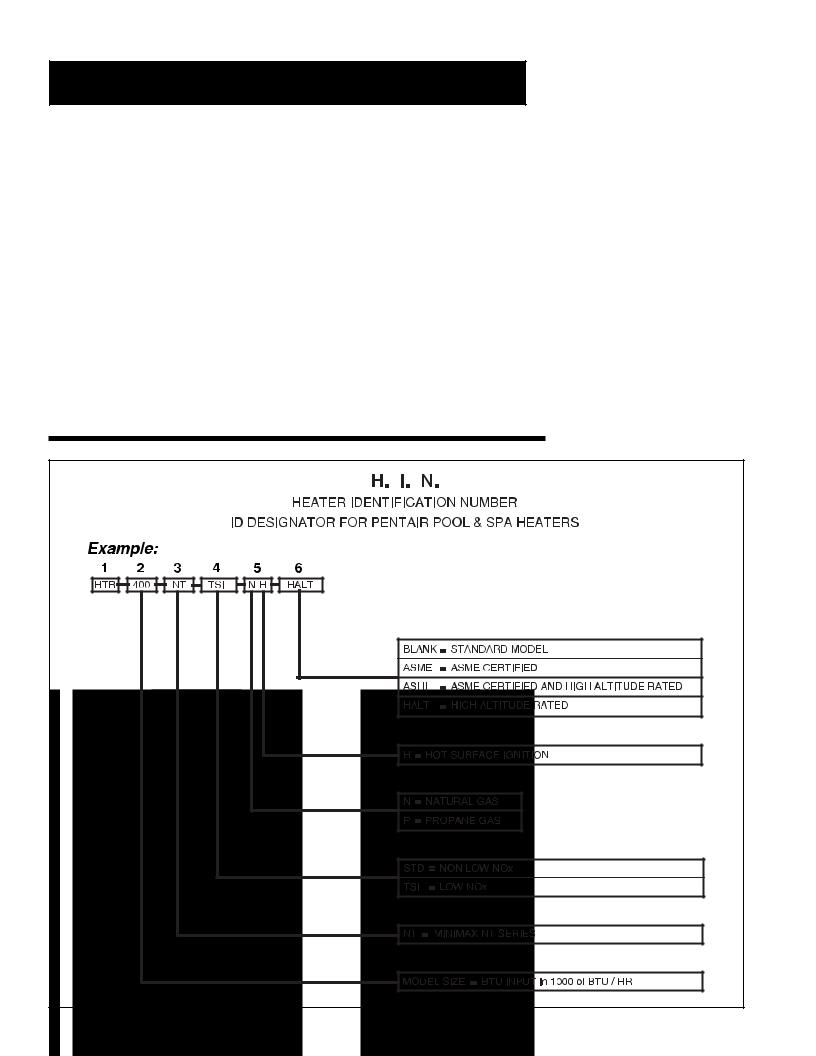
Section I.Heater Identification Information |
4 |
|
|
|
|
Heater Identification Information
To identify the heater, see rating plate on the inner front panel of the heater. There are two designators for each heater, one is the Model Number and the other is the Heater Identification Number (HIN).
a.Heater Identification Number (HIN)
The following example simplifies the identification system:
1)HTR : Heater
2)(200, 250, 300 or 400) : Input rating (Btu/hr) X 1000
3)NT : MiniMax NT Series
4)STD or TSI : Series Character
5)NH or PH: Gas type (Natural gas or Propane gas) and ignition system (Hot Surface Ignition)
6)Options :
Blank: Standard Model
ASME: ASME Certified (Bronze Headers)
ASHI: ASME Certified Bronze Header and High Altitude Rating HALT: High Altitude Rating
HEATER IDENTIFICATION INFORMATION — (HIN)
P/N |
472235 |
Rev. E |
4-15-05 |

Section II. Introduction |
5 |
Introduction
MiniMax® NT Series
Pool and Spa Heaters
Congratulations on your purchase of a MiniMax NT high performance heating system. Proper installation and service of your new heating system and correct chemical maintenance of the water will ensure years of enjoyment. The MiniMax NT is a compact, lightweight, efficient, induced-draft, gas fired high
performance pool and spa heater that can be directly connected to schedule 40 PVC pipe. The MiniMax NT also comes equipped with the Pentair multifunction temperature controller which shows, at a glance,
the proper functioning of the heater. All MiniMax NT heaters are designed with a direct ignition device, HSI (hot-surface ignition), which eliminates the need for a standing pilot. The MiniMax NT requires an external power source (120/240 VAC 60 Hz) to operate.
This instruction manual provides operating instructions, installation and service information for the MiniMax NT high performance heater. The information in this manual applies to all MiniMax NT models. It is very important that the owner/installer read and understand the section covering installation instructions, and recognize the local and state codes before installing the MiniMax NT. History and experience has shown that most heater damage is caused by improper installation practices.
IMPORTANT NOTICES
...For the installer and operator of the MiniMax NT pool and spa heater. The manufacturer’s warranty may be void if, for any reason, the heater is improperly installed and/or operated. Be sure to follow the instructions set forth in this manual. If you need any more information, or if you have any questions regarding to this pool heater, please contact Pentair Water Pool and Spa, Inc. at (800) 831-7133.
WARRANTY INFORMATION
The MiniMax NT pool heater is sold with a limited factory warranty. Specific details are described on the warranty registration card which is included with the product. Return the warranty registration card after filling in the serial number from the rating plate inside the heater.
Pentair Pool Products’ high standards of excellence include a policy of continuous product improvement resulting in your state-of-the-art heater. We reserve the right to make improvements which change the specifications of the heater without incurring an obligation to update the current heater equipment.
These heaters are designed for the heating of swimming pools and spas, and should never be used as space heating boilers, general purpose water heaters, in non-stationary installations, or for the heating of salt water. The manufacturer’s warranty may be void if, for any reason, the heater is improperly installed and/or operated. Be sure to follow the instructions set forth in this manual.
 CAUTION
CAUTION
OPERATING THIS HEATER CONTINUOUSLY AT WATER TEMPERATURE BELOW 68° F. WILL CAUSE HARMFUL CONDENSATION AND WILL DAMAGE THE HEATER AND VOID THE WARRANTY. Do not use
the heater to protect pools or spas from freezing if the final maintenance temperature desired is below 68° F., as this will cause condensation related problems.
Rev. E 4-15-05 |
P/N 472235 |
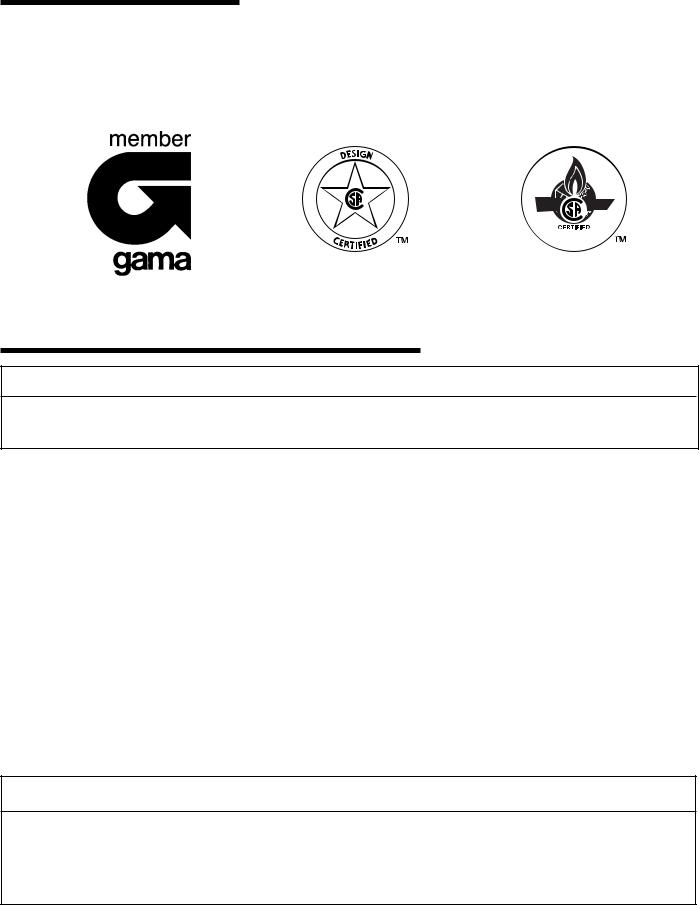
Section II. Introduction |
6 |
|
|
CODE REQUIREMENTS
The installation must conform with local codes or, in the absence of local codes, with the National Fuel Gas Code, ANSI Z223.1/NFPA 54 and/or CSA B149.1, Natural Gas and Propane Installation Codes. The heater, when installed, must be electrically grounded and bonded in accordance with local codes or, in the absence of local codes, in the USA, with the National Electrical Code, ANSI/NFPA 7; in Canada, with Canadian Electric Code, CSA C22.1.
CONSUMER INFORMATION AND SAFETY
 WARNING
WARNING
The U.S. Consumer Product Safety Commission warns that elevated water temperature can be hazardous. See below for water temperature guidelines before setting temperature.
1.Spa or hot tub water temperatures should never exceed 104° F. A temperature of 100° F. is considered safe for a healthy adult. Special caution is suggested for young children. Prolonged immersion in hot water can induce hyperthermia.
2.Drinking of alcoholic beverages before or during spa or hot tub use can cause drowsiness which could lead to unconsciousness and subsequently result in drowning.
3.Pregnant women beware! Soaking in water above 100° F. can cause fetal damage during the first three months of pregnancy (resulting in the birth of a brain-damaged or deformed child). Pregnant women should stick to the 100° F. maximum rule.
4.Before entering the spa or hot tub, the user should check the water temperature with an accurate thermometer. Spa or hot tub thermostats may err in regulating water temperatures by as much as 4° F.
5.Persons with a medical history of heart disease, circulatory problems, diabetes or blood pressure problems should obtain their physician's advice before using spas or hot tubs.
6.Persons taking medication which induce drowsiness, such as tranquilizers, antihistamines or anticoagulants should not use spas or hot tubs.
 WARNING
WARNING
Should overheating occur or the gas supply fail to shut off, turn off the manual gas control valve to the heater. Do not use this heater if any part has been under water. Immediately call a qualified service technician to inspect the heater and to replace any part of control system and gas control which has been under water.
P/N 472235 |
Rev. E 4-15-05 |
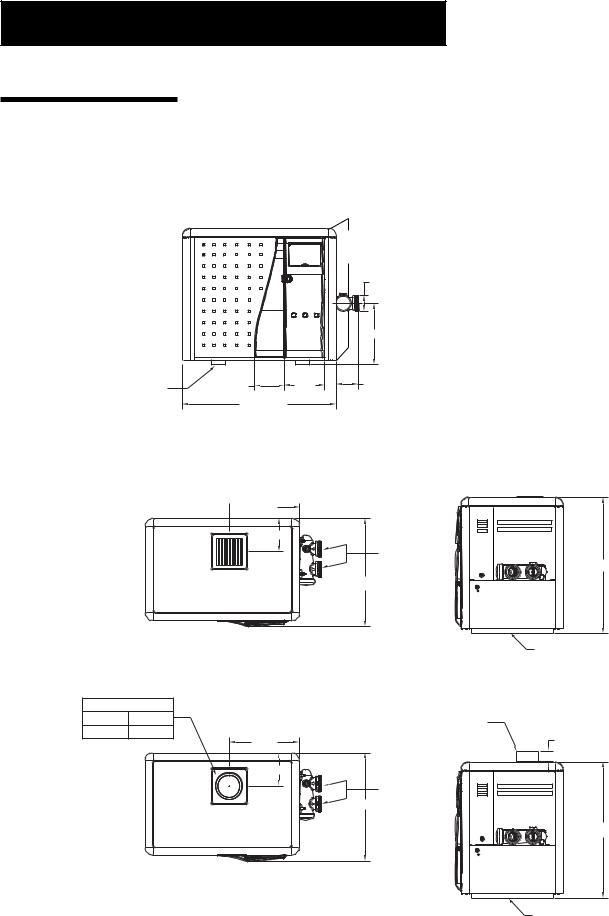
Section III. Installation |
7 |
Installation Instructions
SPECIFICATIONS
These installation instructions are designed for use by qualified personnel only, trained especially for installation of this type of heating equipment and related components. Some states require installation and repair by licensed personnel. If this applies in your state, be sure your contractor bears the appropriate license. See Figure 1 for Outdoor and Indoor Installations.
|
|
|
24.05 |
|
|
|
Heater |
|
|
|
Depth |
|
|
|
3.50 |
|
|
|
14.50 |
LEG |
6.64 |
8.84 |
4.88 |
|
|
"A" DIM. |
|
|
|
DIMENSIONS IN INCHES |
|
|
|
|
|
|
|
|
|
MODEL |
"A" DIM. |
|
|
|
|
|
|
200 |
21.63 |
|
|
|
|
|
|
250 |
24.63 |
|
|
|
|
|
|
300 |
27.63 |
|
|
|
|
|
|
400 |
34.13 |
|
|
|
|
|
|
OUTDOOR INSTALLATION
 15.50
15.50
7.35
2 in. SOCKET
30.63
24.05
LEG
INDOOR INSTALLATION
INDOOR VENT ADAPTOR |
|
|
|
P/N 460506 |
4 in. Kit |
VENT ADAPTOR |
|
|
|
|
|
P/N 460507 |
5 in. Kit |
(See Indoor Venting |
2.00 |
|
15.50 |
Instructions) |
|
|
7.35 |
|
|
|
|
2 in. SOCKET |
|
|
|
24.05 |
|
30.63
Figure 1.
LEG
Rev. E 4-15-05 |
P/N 472235 |
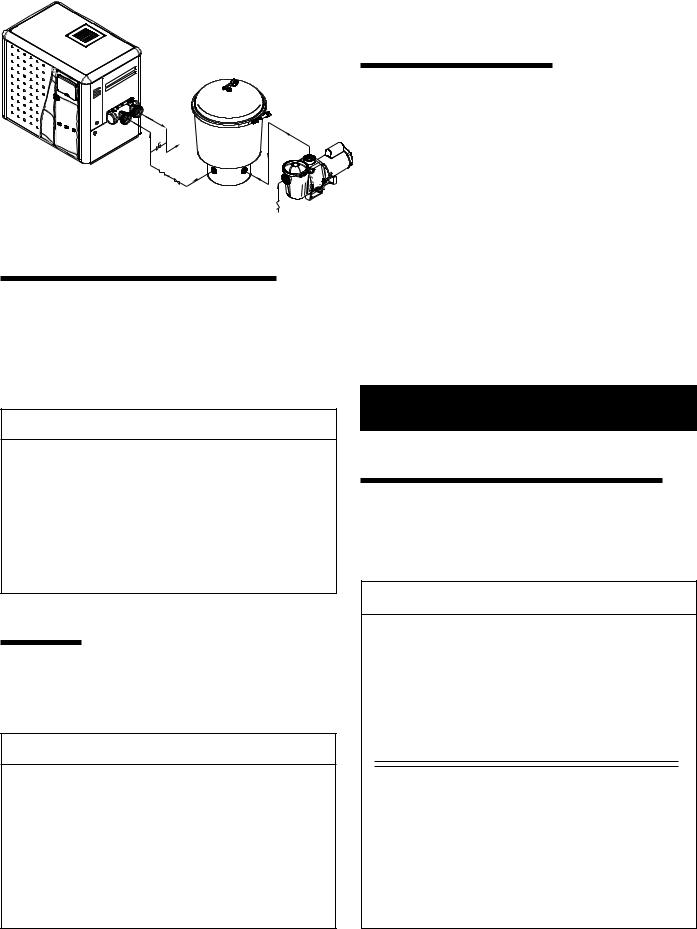
Section III. Installation |
8 |
|
|
|
|
TO |
PUMP |
|
|
POOL |
|
POOL |
|
FILTER |
|
MANUAL |
|
||
HEATER |
|
|
|
BY-PASS |
|
|
|
|
|
|
|
|
CHECK |
GATE |
|
|
VALVE |
|
|
|
VALVE |
|
|
Figure 2. |
|
|
CHECK |
|
|
FROM |
|
|
|
|
VALVE |
|
|
|
POOL |
PLUMBING CONNECTIONS
The MiniMax NT heater has the unique capability of direct schedule 40 PVC plumbing connections. A set of bulkhead fittings is included with the MiniMax NT to insure conformity with Pentair’s recommended PVC plumbing procedure. Other plumbing connections can be used. See Figure 2 for plumbing connections.
 CAUTION
CAUTION
Before operating the heater on a new installation, turn on the circulation pump and bleed all the air from the filter using the air relief valve on top of the filter. Water should flow freely through the heater. Do not operate the heater unless water in the pool/spa is at the proper level. If a manual by-pass is installed, temporarily close it to insure that all air is purged from the heater.
VALVES
When any equipment is located below the surface of the pool or spa, valves should be placed in the circulation piping system to isolate the equipment from the pool or spa. Check valves are recommended to prevent back siphoning.
 CAUTION
CAUTION
Exercise care when installing chemical feeders so as to not allow back siphoning of chemical into the heater, filters or pump. When chemical feeders are installed in the circulation of the piping system, make sure the feeder outlet line is down stream of the heater, and is equipped with a positive seal noncorrosive “Check Valve”, (P/N R172288), between the feeder and heater.
MANUAL BY-PASS
Where the flow rate exceeds the maximum 120 GPM,
a manual bypass should be installed and adjusted. After adjustments are made, the valve handle should be removed to avoid tampering. See Figure 2.
Model |
Min. (GPM) |
Max. (GPM) * |
|
|
|
|
|
200 |
20 |
120 |
|
|
|
|
|
250 |
30 |
120 |
|
|
|
|
|
300 |
30 |
120 |
|
|
|
|
|
400 |
40 |
120 |
|
|
|
|
|
* Do not exceed the maximum recommended |
|
||
flow rate for the connecting piping. |
|
||
|
|
|
|
|
|
Table 1. |
|
See page 30 for Pressure Relief Valve Installations.
BELOW POOL INSTALLATION
If the heater is below water level, the pressure switch must be adjusted. This adjustment must be done by a qualified service technician.
See following CAUTION before installation.
 CAUTION
CAUTION
BELOW OR ABOVE POOL INSTALLATION
The water pressure switch is set in the factory at 1½ PSI. This setting is for a heater installed at pool level or within 3’ above or 3’ below. If the heater is to be installed more that 3’ above or 3’ below, the water pressure switch must be adjusted by a qualified service technician. See page 22, Figure 22.
FLOW SWITCH
If the heater is installed more the 6’ above the pool or more than 10’ below the pool level, you will be beyond the limits of the pressure switch and a flow switch must be installed. Locate and install the flow switch externally on the outlet piping from the heater, as close as possible to the heater. Connect the flow switch wires in place of the water pressure switch wires.
P/N 472235 |
Rev. E 4-15-05 |
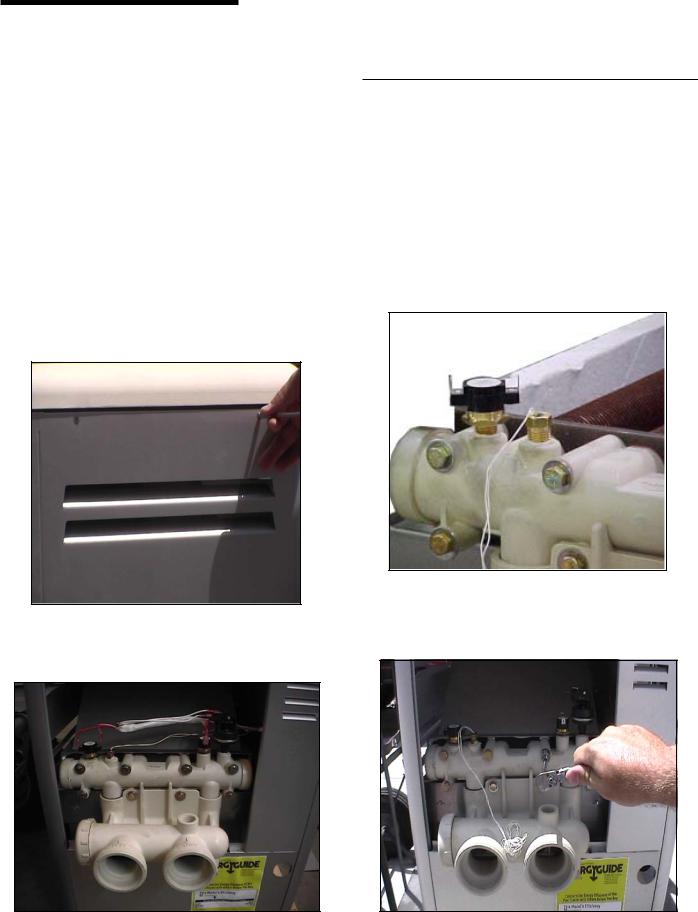
Section III. Installation |
9 |
|
|
WATER CONNECTIONS
Reversing Headers —
Reversible Inlet/Outlet Connection
The MiniMax NT Series heater is factory assembled with right side inlet/outlet water connections. The inlet/outlet header can be reversed for left side water connections without removing the heat exchanger.
Reversing Water Connections
Tools required:
Phillips Screw Driver
9/16 in. Socket and Wrench 1/2 in. & 9/16 in. Open Wrench
1.Remove the right and left large access doors. It is not necessary to remove the top of the heater to gain access to the headers.
2.Disconnect all wires from the high-limit switches except the short jumper wire.
NOTE
Do NOT remove the high-limit and pressure switches or the thermistor from the front header during the reversing procedure, as they will be in the proper location when installed on the left side.
3.Disconnect the water pressure switch wiring.
4.Disconnect the temperature sensor wires from the circuit board and feed them back to the header.
5.Remove the 8 bolts holding the main inlet/outlet head.
Rev. E 4-15-05 |
P/N 472235 |
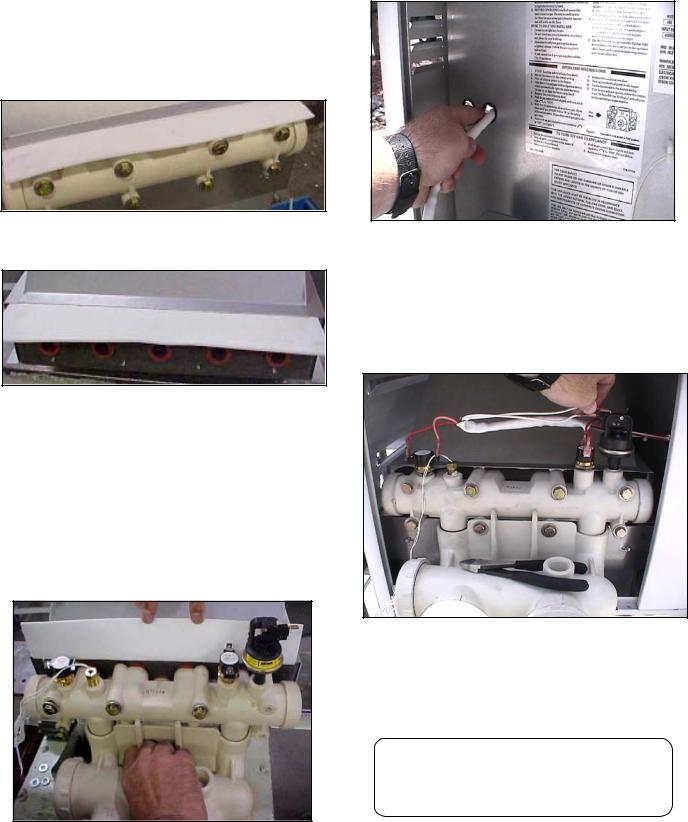
Section III. Installation |
10 |
|
|
Reversible Inlet/Outlet Connection, cont’d.
On the MiniMax NT Series heater there is insulation installed by the factory on the return head side of the heaters. This insulation is there so that if the heads are reversed in the field, during initial installation of the heater, the high limits will be insulated from the heat radiating from the flue collector.
6.Return head in position before removal. This view shows the insulation installed by the factory. Remove the 8 bolts holding the return head in place.
7.When heads are removed, replace the heat exchanger tube seal gaskets.
8.Exchange the inlet/outlet header with the return header. Lift the insulation to allow the main head to be installed. Align header with the heat exchanger. When head is placed into position, release the insulation; it will now shield the high limits from the heat produced by the flue collector. Install header bolts, and tighten snugly by hand. (This will help avoid cross threading.) When tightening, use a cross pattern starting from the center of the header. DO NOT over tighten.
9.Install the temperature sensing probe by passing the wires through the hole provided on the left side of the brace panel. Route wires through the support bracket.
10.Reconnect all the high limit wires and the pressure switch wiring, routing the wires through the same hole as the thermostat sensor wires.
11.Pump and bleed system to check the head for leaks.
12.Reinstall the two large inspection plates on the appropriate side.
Remember: The inlet and outlet markings on the header are still correct.
Do not plumb the heater backwards.
P/N 472235 |
Rev. E 4-15-05 |
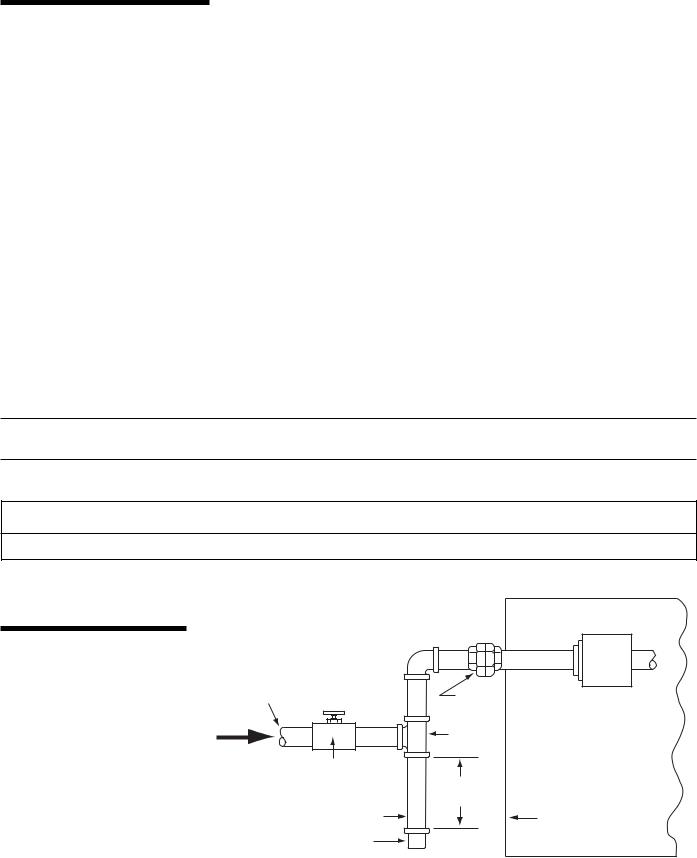
Section III. Installation |
11 |
|
|
GAS CONNECTIONS
GAS LINE INSTALLATIONS
Before installing the gas line, be sure to check which gas the heater has been designed to burn. This is important because different types of gas require different gas pipe sizes. The rating plate on the heater will indicate which gas the heater is designed to burn. The tables, shown on page 12, show which size pipe is required for the distance from the gas meter to the heater. The table is for natural gas at a specific gravity of .65 and propane at a specific gravity of 1.55.
When sizing gas lines, calculate three (3) additional feet of straight pipe for every elbow used. When installing the gas line, avoid getting dirt, grease or other foreign material in the pipe as this may cause damage to the gas valve, which may result in heater failure.
The gas meter should be checked to make sure that it will supply enough gas to the heater and any other appliances that may be used on the same meter. The gas line from the meter will usually be of a larger size than the gas valve supplied with the heater. Therefore a reduction of the connecting gas pipe will be necessary. Make this reduction as close to the heater as possible.
The heater and any other gas appliances must be disconnected from the gas supply piping system during any pressure testing on that system, (greater that ½ PSI). The heater and its gas connection must be leak tested before placing the heater in operation. Do not use flame to test the gas line. Use soapy water or another nonflammable method.
NOTE
A manual main shut-off valve must be installed externally to the heater.
 WARNING
WARNING
DO NOT INSTALL THE GAS LINE UNION INSIDE THE HEATER CABINET. THIS WILL VOID YOUR WARRANTY.
SEDIMENT TRAPS
Install a sediment in front of the gas controls. The sediment trap shall be either a tee fitting with a capped nipple in the bottom outlet which can be removed for cleaning, as illustrated in Figure 3, or a other device recognized as an effective sediment trap. All gas piping should be tested after installation in accordance with local codes.
|
GAS |
GAS |
VALVE |
|
|
SUPPLY |
UNION |
|
TEE |
|
FITTING |
MANUAL |
|
SHUT OFF |
3 INCHES |
VALVE |
MINIMUM |
|
|
NIPPLE |
HEATER CABINET |
CAP |
|
Figure 3.
Rev. E 4-15-05 |
P/N 472235 |
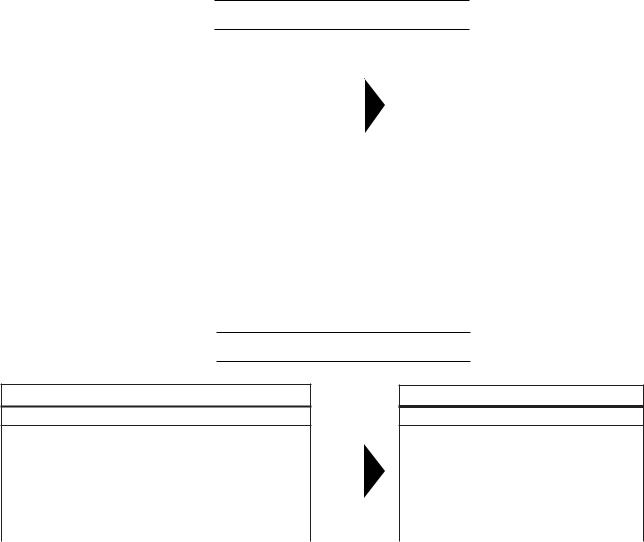
Section III. Installation |
12 |
|
|
GAS PIPE SIZING
|
|
|
|
|
|
|
|
|
|
|
|
|
|
|
|
|
|
Table 2. |
|
|
|
|
|
|
|
|
|
|
|
|
|
|
|
|
|
|
|
||
|
|
|
|
|
PIPE SIZING FOR GAS LINE CONNECTIONS |
|
|
|
|
||||||||||
|
|
|
|
|
MAXIMUM EQUIVALENT PIPE LENGTH (Ft.) |
|
|
|
|
||||||||||
|
|
|
|
|
|
|
Natural Gas at 1000 B.T.U. per Cubic Foot |
|
|
|
|
|
|
||||||
|
|
|
|
|
|
|
|
|
|
|
|
|
|
|
|
|
|
|
|
|
|
|
|
|
|
Propane Gas at 2500 B.T.U. per Cubic Foot |
|
|
|
|
|||||||||
|
|
|
|
|
|
|
|
|
|
|
|
|
|
|
|
|
|
||
|
|
|
1/2” |
3/4” |
1” |
1-1/4” |
1-1/2” |
|
2” |
2-1/2” |
|||||||||
|
|
|
|
|
|
|
|
|
|
|
|
|
|
|
|
|
|
|
|
|
MODEL |
NAT |
PRO |
NAT |
|
PRO |
NAT |
PRO |
NAT |
PRO |
NAT |
|
PRO |
|
NAT |
PRO |
NAT |
PRO |
|
|
|
|
|
|
|
|
|
|
|
|
|
|
|
|
|
|
|
|
|
|
200 |
- |
20’ |
30’ |
|
80’ |
125’ |
250’ |
450’ |
600’ |
- |
|
- |
|
- |
- |
- |
- |
|
|
|
|
|
|
|
|
|
|
|
|
|
|
|
|
|
|
|
|
|
|
250 |
- |
10’ |
20’ |
|
50’ |
70’ |
150’ |
250’ |
500’ |
600’ |
|
- |
|
- |
- |
- |
- |
|
|
|
|
|
|
|
|
|
|
|
|
|
|
|
|
|
|
|
|
|
|
300 |
- |
- |
10’ |
|
30’ |
50’ |
100’ |
200’ |
350’ |
400’ |
|
600’ |
|
- |
- |
- |
- |
|
|
|
|
|
|
|
|
|
|
|
|
|
|
|
|
|
|
|
|
|
|
400 |
- |
- |
- |
|
10’ |
20’ |
60’ |
100’ |
150’ |
200’ |
|
450’ |
|
400’ |
- |
- |
- |
|
|
|
|
|
|
|
|
|
|
|
|
|
|
|
|
|
|
|
|
|
“RESIDENTIAL” PROPANE GAS 2 STAGE REGULATION
In many Propane gas line installations, the gas supplier and/or installer will utilize a two stage regulation process where by at the supply tank they will install the first stage gas regulator, which would be at a higher pressure, usually 10 psi. This higher pressure allows for a much longer distance and in a much smaller pipe size. Then within a short distance of the pool heater, usually around 24 inches, they will install a second regulator, which is the second stage, and this would be set at the required inlet pressure of the heater.
See “Gas Pressure Requirement Charts”
Stage One "High Pressure" Gas Pipe Sizing |
|
|
|
Stage Two "Low Pressure" Gas Pipe Sizing |
|
|||||
10 PSI @ 2500 B.T.U. Per CU. FT. |
|
|
|
Stage 2 set at 14 in. W.C. |
|
|||||
|
|
|
|
|
|
|
|
|
|
|
MAXIMUM EQUIVALENT PIPE LENGTH |
|
|
|
MAXIMUM EQUIVALENT PIPE LENGTH |
|
|||||
|
|
|
|
|
|
|
|
|
|
|
Model |
0 to 50 Ft. |
50 to 100 Ft. |
100 to 150 Ft. |
|
|
|
Model |
0 to 10 Ft. |
10 to 20 Ft. |
|
|
|
|
|
|||||||
200 through 400 |
1/2 in. |
1/2 in. |
1/2 in. |
|
|
|
200 through 400 |
3/4 in. |
3/4 in. |
|
|
|
|
Table 3. |
|
|
Table 4. |
||||
|
|
|
|
|
|
|
|
|
|
|
|
|
|
|
|
|
|
|
|
|
|
“RESIDENTIAL” NATURAL GAS 2 STAGE REGULATION
In many Natural gas line installations, the gas supplier and/or installer may utilize a two stage regulation process where by at the streets main gas supply they will install the first stage gas regulator, which would be at a higher pressure. This higher pressure is usually set at 2 psi or 5 psi and can be for long distances and in a much smaller pipe size. Then within a short distance of the pool heater, generally around 24 inches, they will install a second regulator, which is the second stage. This second stage regulator would be set at the minimum operating pressure for the heater. For “Natural Gas Pentair Pool Heaters” the minimum is 7 inches W.C.
See “Gas Pressure Requirement Charts”
Stage One "High Pressure" Gas Pipe Sizing
2 PSI @ 1000 B.T.U. Per CU. FT.
MAXIMUM EQUIVALENT PIPE LENGTH
|
Model |
0 to 50 Ft. |
50 to 100 |
Ft. |
100 to 150 Ft. |
|
|
||
|
|
|
|||||||
|
|
|
|
|
|
|
|
|
|
200 |
through 300 |
1/2 |
in. |
1/2 |
in. |
|
1/2 in. |
|
|
|
|
|
|
|
|
|
|
||
|
400 |
3/4 in. |
3/4 in. |
|
3/4 in. |
|
|
||
|
|
|
|
|
|
|
|||
|
5 PSI @ 1000 B.T.U. Per CU. FT. |
|
|
||||||
|
|
|
|
|
|
|
|
|
|
200 |
through 400 |
1/2 |
in. |
1/2 |
in. |
|
1/2 in. |
|
|
|
|
|
|
|
|
|
|
|
|
Table 5.
Stage Two "Low Pressure" Gas Pipe Sizing
Stage 2 set at 7 in. W.C.
MAXIMUM EQUIVALENT PIPE LENGTH
Model |
0 to 10 Ft. |
10 to 20 Ft. |
|
|
|
|
|
200 through 300 |
3/4 |
in. |
3/4 in. |
|
|
|
|
400 |
3/4 |
in. |
1 in. |
|
|
|
|
Stage 2 set at 7 in. W.C.
200 through 400 |
3/4 in. |
1 in. |
|
|
|
Table 6.
P/N 472235 |
Rev. E 4-15-05 |
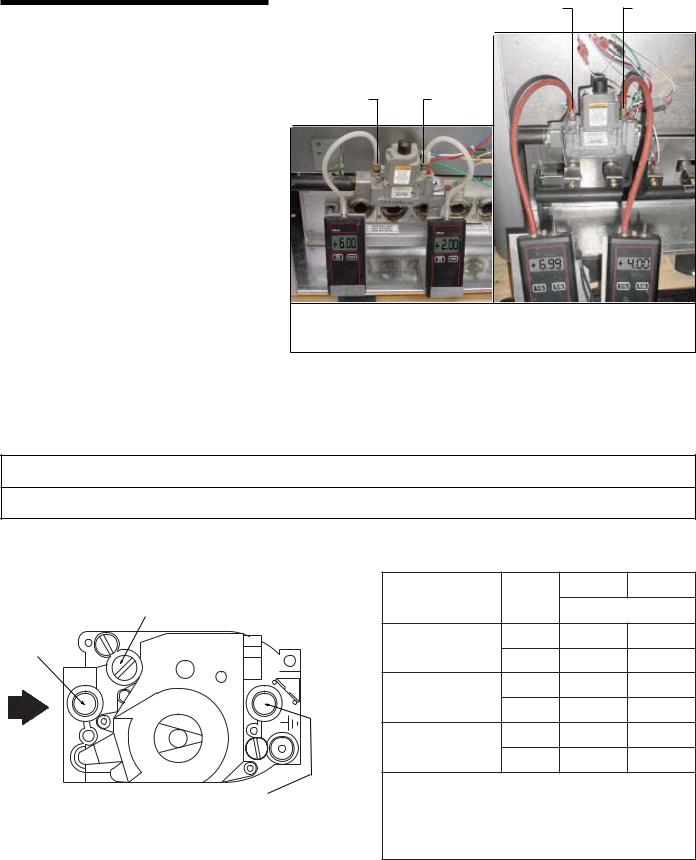
Section III. Installation |
13 |
|
|
TESTING GAS PRESSURE
1.Push the power switch to “OFF”.
2.Turn the gas valve knob to “OFF”.
3.Remove 1/8 in. NPT plug on the outlet side of the valve and screw in the fitting from the Manometer kit.
4.Connect the Manometer hose to the fitting.
5.Turn the gas valve knob to “ON”.
6.Turn on the heater and read the Manometer.
7.The Manometer must read per the values of the Gas Pressure Requirement Table, on manifold side of the gas valve, while operating.
8.If reading is below specified; check the inlet pressure while the heater is running to make sure of proper supply before attempting adjustments.
Inlet Manifold
Inlet Manifold
MiniMax NT TSI |
MiniMax NT STD |
Illustrations above are for Natural Gas, for Propane requirements, see Table 7.
9.For adjustment, remove the Regulator Adjustment Cap and using a screwdriver turn the screw clockwise to increase - counterclockwise to decrease gas pressure.
 CAUTION
CAUTION
The use of Flexible Connectors (FLEX) is NOT recommended as they cause excessive high gas pressure drops.
GAS PRESSURE REQUIREMENTS
|
|
|
|
Natural |
Propane |
|
|
|
Gas Pressure |
Model |
|
|
|
|
Regulator Adjustment Cap |
|
|
Inches W.C. |
||
|
|
|
|
|
||
1/8" NPT Plug |
|
Maximum Inlet |
STD |
10 |
14 |
|
(Inlet Press) |
|
TSI |
10 |
N/A |
||
|
|
|
||||
|
|
|
STD |
5* |
12 |
|
|
|
Minimum Inlet |
|
|
|
|
|
|
|
TSI |
4 |
N/A |
|
|
ON |
Manifold |
STD |
4 |
11 |
|
|
|
|
|
|
||
|
|
|
TSI |
2 |
N/A |
|
|
OFF |
|
|
|
|
|
|
1/8" NPT Plug |
NOTE: All readings must be taken while heater is |
||||
|
operating. Any adjustments or readings made while |
|||||
Figure 4. |
(Manifold Press) |
|||||
heater is off will result in performance problems. |
||||||
|
|
|||||
|
|
All Values are +/- 0.2 inch W.C. |
|
|
||
|
|
* 6 inch. W.C. for STD 400 Model. |
|
|
||
|
|
|
|
|
Table 7. |
|
Rev. E 4-15-05 |
P/N 472235 |
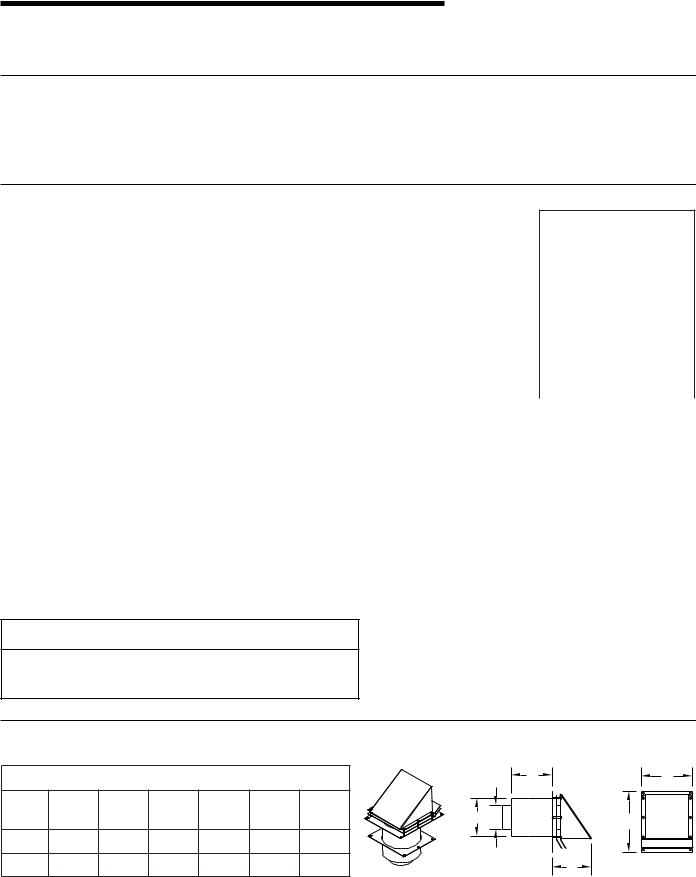
Section III. Installation |
14 |
|
|
INDOOR VENTING — General Requirements
The vent pipe must be the same size or larger. The MiniMax NT heaters are capable of a 360-degree discharge rotation and operate with a positive vent static pressure and with a vent gas temperature less than 400° F. The total length of the horizontal run must not exceed the length that is listed below in the tables.
NOTE
The allowable vent runs for each vent pipe diameter are different and can not be exceeded.
Each 90-degree elbow reduces the maximum horizontal vent run by 8 feet and each 45-degree elbow in the vent run reduces the maximum vent run by 4 feet. See the tables below for the maximum vent lengths using 90-degree and 45-degree elbows.
The MiniMax NT is a “Category III” appliance and is an induced-draft pool and spa heater which uses positive pressure to push flue gases through the vent pipe to the outside. This requires a completely sealed vent system—single wall vent pipe with sealed-seams and joints. Flue gases under positive pressure may escape into the dwelling with any cracks or loose joints in the vent pipe, or improper vent installation. The vent pipe must be of a sealed-seam construction, such as those listed for use with “Category III Appliances”, and for operating temperatures less than 400° F. The use of listed thimbles, roof jacks and/or side vent terminals are required; and the proper clearances to combustible materials must be maintained in accordance with type of vent pipe employed—in the absence of a clearance recommendation by the vent pipe manufacturer, the requirements of the Uniform Mechanical Code should be met. The ventilation air requirements for the MiniMax NT heater can be
4 inch Vent Pipe
Number of |
Maximum |
||
Elbows |
|||
Vent Run |
|||
|
|
||
90° |
45° |
(Feet) |
|
|
|
|
|
1 |
— |
22 |
|
|
|
|
|
1 |
1 |
18 |
|
|
|
|
|
1 |
2 |
14 |
|
|
|
|
|
2 |
— |
14 |
|
|
|
|
|
found on page 16. It is recommended that vent runs over 18 feet be insulated to reduce condensation related problems and/or the use of a condensate trap in the vent run close to the heater may be necessary in certain installations such as cold climates. The MiniMax NT heater is suitable for through-the- wall venting, see table and dimensions below.
Recommended sources for Side-wall vent hood terminals include: The Field Controls Co. (2308 Airport Road, Kingston, NC 28501, (800)742-8368) and Tjernlund Products Inc. (1601 Ninth Street, White Bear Lake, MN 55110, (800) 255-4208)— consult manufacturer for model information and availability.
 CAUTION
CAUTION
Do NOT combine exhaust vent pipes to a common exhaust vent in multiple unit installations. Run separate vent pipes.
|
|
|
|
|
Table 8. |
|
|
|
|
|
|
|
|
5 inch Vent Pipe |
5 inch Vent Pipe |
|||||
|
|
|
|
|
|
|
Number of |
Maximum |
Number of |
Maximum |
|||
Elbows |
Elbows |
|||||
Vent Run |
Vent Run |
|||||
|
|
|
|
|||
90° |
45° |
(Feet) |
90° |
45° |
(Feet) |
|
|
|
|
|
|
|
|
0 |
2 |
45 |
2 |
2 |
29 |
|
|
|
|
|
|
|
|
1 |
— |
45 |
2 |
3 |
25 |
|
|
|
|
|
|
|
|
1 |
1 |
41 |
2 |
4 |
21 |
|
|
|
|
|
|
|
|
1 |
2 |
37 |
3 |
— |
29 |
|
|
|
|
|
|
|
|
1 |
3 |
33 |
3 |
1 |
25 |
|
|
|
|
|
|
|
|
2 |
— |
37 |
3 |
2 |
21 |
|
|
|
|
|
|
|
|
2 |
1 |
33 |
4 |
— |
21 |
|
|
|
|
|
|
|
|
|
|
|
|
|
Table 9. |
|
|
THROUGH WALL VENT KITS FOR HEATERS |
|
C |
F |
||||||||
Part |
Dim. A |
Dim. B |
Dim. C |
Dim. D |
Dim. E |
Dim. F |
|
|
||||
Number |
A |
|
||||||||||
|
|
|
|
|
|
|
|
|
B |
E |
||
|
|
|
|
|
|
|
|
|
|
|
|
|
471532 |
4 |
in. Dia. |
6 |
in. Dia. |
8½ in. |
6 5/16 in. |
12 |
5/8 in. |
10 |
5/8 in. |
|
|
471543 |
5 |
in. Dia. |
8 |
in. Dia. |
8½ in. |
8 in. |
12 |
5/8 in. |
10 |
5/8 in. |
|
D |
Table 10. |
|
|
|
|
|
|
|
|
Figure 5. |
|
||
P/N 472235 |
Rev. E 4-15-05 |
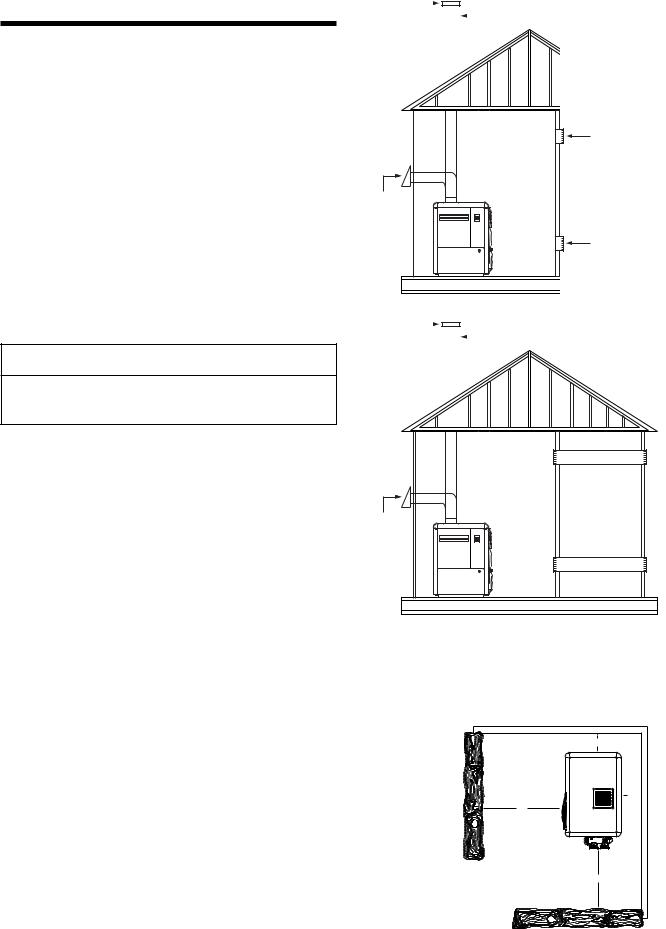
Section III. Installation |
15 |
|
|
INDOOR INSTALLATION (USA ONLY)
OUTDOOR SHELTER INSTALLATION (CANADA)
See page 16 for Vent Adaptors
All products of combustion and vent gases must be completely removed to the outside atmosphere through a vent pipe which is connected to the stack adaptor. A vent pipe extension of the same size must be connected to the vent adaptor and extended at least 2 feet higher than highest point of the roof within a 10 foot horizontal radius, and at least 3 ft. higher than the point at which it passes through the roof, or as permitted by local code; see Figures 6, 7 and 12. The vent should terminate with an approved vent cap (weather cap) for protection against rain or blockage by snow. Insulated vent pipe and an approved roof jack shall be employed through the roof penetration.
The heater must be located as close as practical to a chimney or gas vent.
 CAUTION
CAUTION
The heater should be installed at least 5 feet away from the pool or spa.
The heater must be placed in a suitable room with adequate ventilation and on a leveled floor, where leakage from heat exchanger or water connections will not result in damage to the area adjacent to the heater or the structure. When such locations cannot be avoided, it is recommended that a suitable drain pan with adequate drainage, be installed under the heater. The pan must not restrict air flow.
It is recommended to install the heater on fire-resistance slabs. Do not install the heater directly on a combustible wood floor without placing a non-combustible material between the floor and the heater. Heaters must NEVER be installed directly on carpeting.
Installations in basements, garages, or underground structures where flammable liquids may be stored must have the heater elevated 18 inches from the floor. The following minimum clearances from combustible materials must be provided.
|
|
INSTALLATION |
|
|
|
SIDE |
|
|
|
INDOOR |
|
|
||
|
OF |
OUTDOOR |
|
|
|
(Outrdoor Shelter) |
|
||
|
HEATER |
|
|
|
|
|
|
|
|
|
|
INCHES |
INCHES |
|
|
|
|
|
|
|
WATER PIPING |
18 |
18 |
|
|
|
|
|
|
|
BLANK |
6 |
6 |
|
|
|
|
|
|
|
REAR |
6 |
6 |
|
|
|
|
|
|
|
TOP * |
18 |
Open Un-roofed Area |
|
|
|
|
|
|
|
FRONT |
24 |
24 |
|
|
|
|
|
|
|
* To ceiling or roof. |
|
Table 11. |
|
|
|
|
|
|
Rev. E 4-15-05 |
|
|
|
|
|
|
|
|
|
|
Chimney or Gas Vent |
|
|
|
|
|
|
|
Vent Cap and |
|
|
|
|||
|
|
|
||||
|
|
|
|
|||
Riser Furnished |
|
|
|
|
||
by Installer |
|
|
|
|
||
|
|
|
|
|
|
|
Outlet Air
Opening
Optional
Side
Wall Vent
Inlet Air
Opening
Heater
Figure 6.
|
|
|
|
|
|
Chimney or Gas Vent |
|
|
|
|
|
|
|
Vent Cap and |
|
|
|
|||
|
|
|
||||
|
|
|
|
|||
Riser Furnished |
|
|
|
|
||
by Installer |
|
|
|
|
||
|
|
|
|
|
|
|
Outlet Air Opening
Optional
Side
Wall Vent
Inlet Air Opening
Heater
Figure 7.
The heater should not be installed closer than 6 inches to any fences, walls or shrubs at any side or back, nor closer than 18 inches at the plumbing side. A minimum clearance of 24 inches must be maintained at the front of the heater.
|
|
6" |
|
|
DOOR |
6" |
|
24" |
|
|
|
|
|
18" |
|
Figure 8. |
|
|
|
|
|
P/N |
472235 |
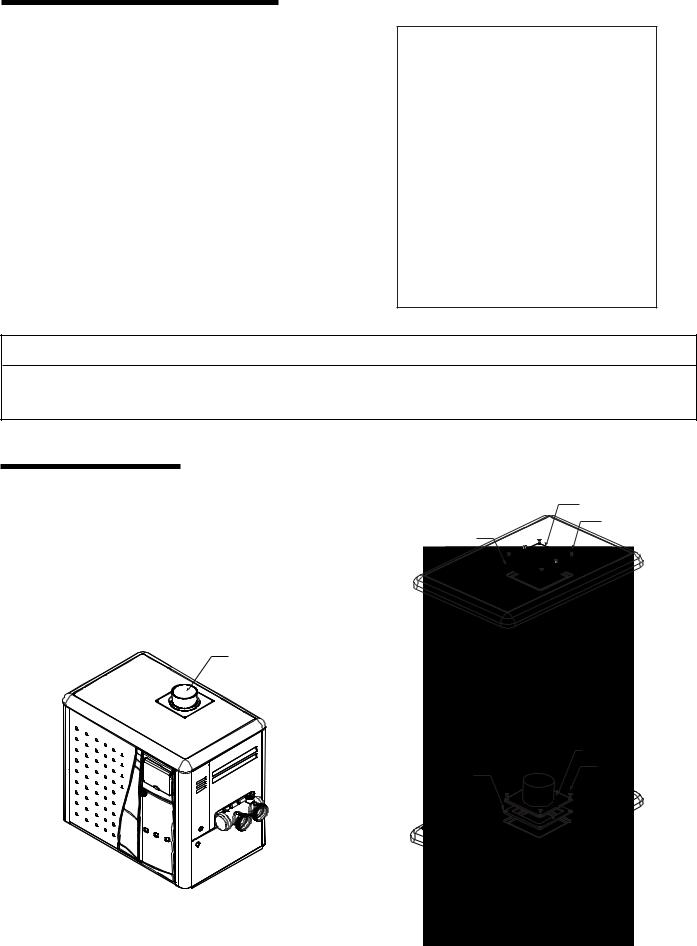
Section III. Installation |
16 |
|
|
|
|
COMBUSTION AIR SUPPLY
For indoor installation, the heater location must provide sufficient air supply for proper combustion and ventilation of the surrounding area.
The requirements for the air supply specify that the room in which a heater is installed should be provided with two permanent air supply openings; one within 12 inches of the ceiling, the other within 12 inches of the floor. These openings shall directly, or through duct, connect to outdoor air.
Pentair Water Pool and Spa, Inc. does not recommend indoor installations that do not provide combustion air from outside the building.
Air Supply Requirements Guide
for MiniMax NT Heaters
Net Free open Area for Each Opening * (Square Inches)
Heater |
Ducted from |
Direct from |
Size |
Outside |
Outside |
|
|
|
200 |
100 |
50 |
|
|
|
250 |
125 |
63 |
|
|
|
300 |
150 |
75 |
|
|
|
400 |
200 |
100 |
|
|
|
* Area indicated is for one of two openings; one at floor level and one at the ceiling.
NOTE: If using louvered type or screen type openings, check with Louver/Screen Manufacturers to correct for the Louver/Screen resistance.
Table 12.
 CAUTION
CAUTION
Chemicals should not be stored near the heater installation. Combustion air can be contaminated by corrosive chemical fumes which can void the warranty.
VENT ADAPTORS
(FITS ALL MODELS)
The proper vent adaptor must be installed on the heater as shown below in Figure 9.
Product No. |
Vent Dia. |
|
|
460506 |
4 in. |
|
|
460507 |
5 in. |
|
|
Vent
Adaptor
1.Remove the six (6) retaining screws from the old exhaust grill and discard the screws, gasket, and exhaust grill as shown in Figure 10.
EXHAUST GRILL
SCREWS (6)
GASKET
Figure 10.
2.Install the Vent Adaptor as shown in Figure 11. Make sure the holes in the gasket, metal flange of the main vent assembly, and heater cover are aligned before securing into place using the six (6) screws provided in the Vent Adaptor Kit.
METAL FLANGE
SCREWS (6)
GASKET
Figure 9. |
Figure 11. |
P/N 472235 |
Rev. E 4-15-05 |
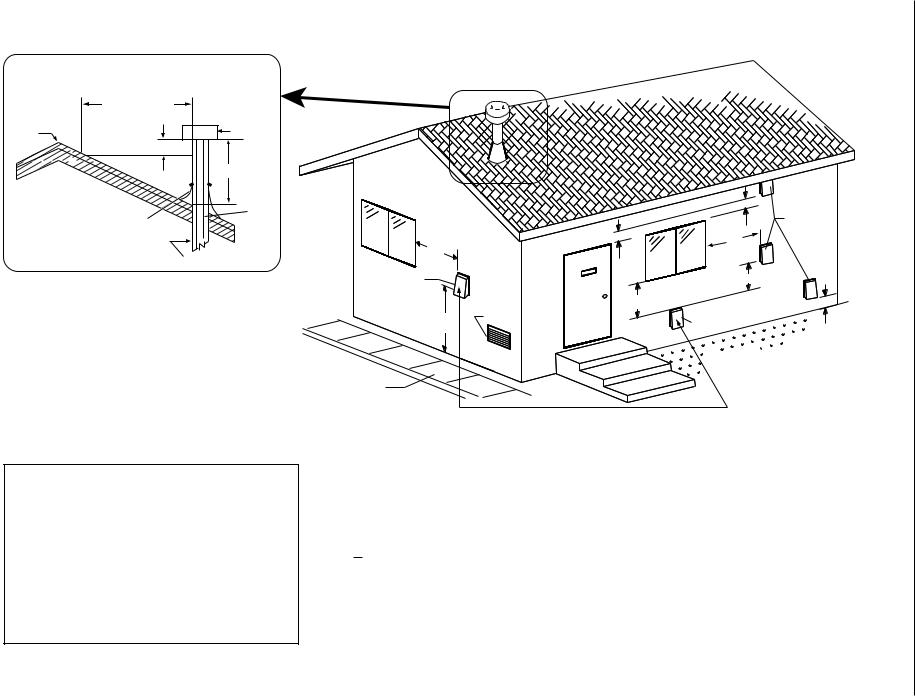
05-15-4 E .Rev
472235 P/N
|
vent terminated at least 24" |
|
above any object within 10 ft. |
More Than10 ft. |
|
Ridge |
Vent Cap |
|
2 ft. min. |
|
3 ft. min. |
|
Roof |
Roof |
Thimble |
Jack |
|
|
Chimney/Gas Vent |
Vent for roof penetration installations:
 must extend at least 3 ft. higher than the point at which it passes through the roof, or as permitted by local code.
must extend at least 3 ft. higher than the point at which it passes through the roof, or as permitted by local code.
 must use a roof thimble through the roof penetration.
must use a roof thimble through the roof penetration.
 must terminate with an approved (listed) roof jack, storm collar, and vent/weather cap.
must terminate with an approved (listed) roof jack, storm collar, and vent/weather cap.
Vent pipe extension:
 must be the same diameter as the vent connector.
must be the same diameter as the vent connector.
 must be suitable for use with category III appliances with flue gas temperature ratings less than 400 deg. F.
must be suitable for use with category III appliances with flue gas temperature ratings less than 400 deg. F.
 may use a single wall vent pipe with permanently sealed seams, joints and proper insulating materials.
may use a single wall vent pipe with permanently sealed seams, joints and proper insulating materials.
INDOOR INSTALLATIONS
MINIMAX NT VENTING GUIDELINES
|
|
1' |
m in |
. |
|
|
Vent Hood |
||
|
|
|
|
|
1' |
min |
. |
4' |
|
|
|
|||
4' |
|
|
|
|
Vent Hood |
|
|
|
3' |
|
4' |
|
|
|
Force Air Inlet |
|
|
|
1' min. |
|
Vent Hood |
above grade |
||
7' |
|
|||
Walkway
Recommended sources for side wall Vent Hood;
see "Section Venting".
Vent termination for side wall installations:
 must be not less than 7 ft. above public walkways.
must be not less than 7 ft. above public walkways.
 must be at least 3 ft. above any outside air intake located within a 10 ft. radius.
must be at least 3 ft. above any outside air intake located within a 10 ft. radius.
 must NOT be within 3 ft. of an inside corner of the structure.
must NOT be within 3 ft. of an inside corner of the structure.  must be at least 1 ft. above grade.
must be at least 1 ft. above grade.
 must be located the following distances away from any door, window, or gravity air inlet:
must be located the following distances away from any door, window, or gravity air inlet:
 4 ft. below
4 ft. below
 4 ft. horizontally
4 ft. horizontally  1 ft. above
1 ft. above
Air Supply
 Clearances indicated are for non-mechanical air supply inlet to the building.
Clearances indicated are for non-mechanical air supply inlet to the building.
For mechanical air supply inlet, a minimum horizontal clearance of 10 feet |
Figure 12. |
should be maintained away from the vent termination. |
|
Installation .III Section
17
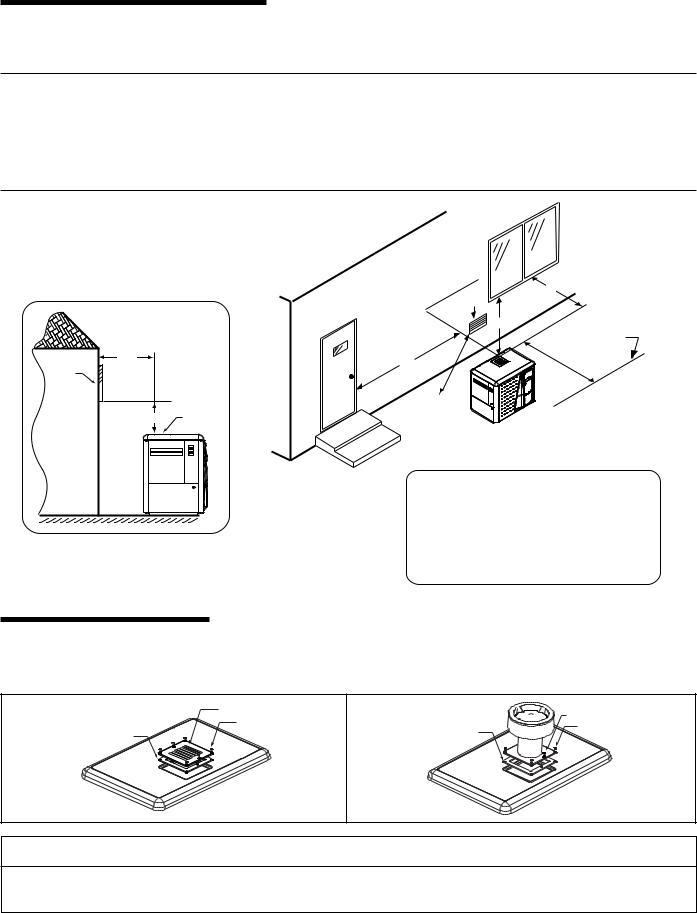
Section III. Installation |
18 |
|
|
OUTDOOR INSTALLATION (Outdoor Shelter Installation in Canada, see page 15)
For outdoor installation with an exhaust grill, the heater must be placed in a suitable area on a level, noncombustible surface. Do not install the heater under an overhang with clearances less than 3 feet from the top of the heater. The area under an overhang must be open on three sides. Do NOT, under any circumstances, install the heater under ANY deck.
IMPORTANT!
•In an outdoor installation it is important to ensure water is diverted from overhanging eves with a proper gutter/drainage system. The heater must be set on a level foundation for proper drainage.
•Under certain conditions, “heavy rains or unusually high winds”, it may be necessary to install an outdoors vent. In this situation, use Outdoor Vent Kit, P/N 460424, (see below).
•This unit shall not be operated outdoors at temperatures below -20o F.
OUTDOOR INSTALLATION
VENTING GUIDELINES
 4' 3'
4' 3'
SIDE VIEW |
4' |
|
4 ft. |
4' |
|
|
Window |
|
4 ft. |
Exhaust Grill |
|
(Vent) |
Building |
|
Heater |
|
(side view) |
|
|
Property Line |
|
|||
|
|
|
|
|
codes. |
|
|
|
building |
ents |
|
Force |
|
|
local |
requirem |
|
|
|
setback |
|
|
|
Air Inlet |
Check |
|
|
|
|
|
|
|
|
|
|
|
for |
|
|
|
|
Vent Termination:
 Must be at least 3 ft. above any forced air inlet located within a 10 ft. radius.
Must be at least 3 ft. above any forced air inlet located within a 10 ft. radius.
 Must be located 4 feet away from the building wall Figure 13. openings, and at the following distances away from
Must be located 4 feet away from the building wall Figure 13. openings, and at the following distances away from
any door, window, or gravity air inlet:
 4 ft. below,
4 ft. below,
 4 ft. horizontally
4 ft. horizontally
OUTDOOR VENT KIT
1.Remove the six (6) retaining screws from the old exhaust grill and discard the screws, gasket, and exhaust grill as shown in Figure 14.
2.Install the Outdoor Vent Kit, (P/N 460424), as shown in Figure 15. Make sure the holes in the gasket, metal flange of the main vent assembly, and heater cover are aligned before securing into place using the six (6) screws provided in the Outdoor Vent Kit.
|
EXHAUST GRILL |
METAL FLANGE |
|
SCREWS (6) |
|
|
SCREWS (6) |
|
|
|
|
GASKET |
|
GASKET |
|
|
Figure 14. |
Figure 15. |
 CAUTION
CAUTION
If installing the heater next to or near an air conditioning unit or a heat pump, allow a minimum of 36 in. between the air conditioning unit and the heater.
P/N 472235 |
Rev. E 4-15-05 |
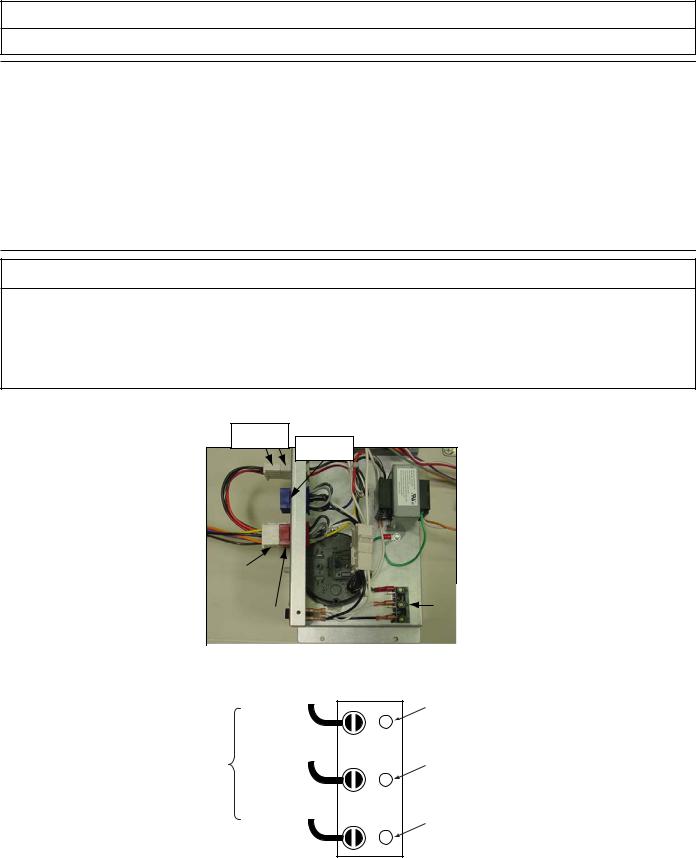
Section III. Installation |
19 |
||
|
|
|
|
|
ELECTRICAL CONNECTIONS |
||
|
|
|
|
|
|
|
|
|
Electrical Rating 60 Hz |
120 / 240 Volts AC, single phase |
|
 CAUTION
CAUTION
This heater is designed to operate at 120 or 240 VAC. It is not recommended to be connected to OR operate on a 208 VAC.
NOTE
•The MiniMax NT heater is prewired for 240-volt AC connection using the “RED” connector and the “BEIGE” common connector; see Figure 16 below. For 120-volt AC supply, remove the “BEIGE” common connector and plug it into the “BLUE” common connector.
•When connecting the power supply to the “Line Terminal Block” inside the junction box, follow the polarity as shown below. Connecting to 120 VAC, make sure that you connect the wire to the terminal (L), the neutral wire is connected to the neutral terminal (N) and the ground is connected to the ground terminal (GND); see below, Figure 17.
•If any of the original wiring supplied with this heater must be replaced, installer must supply (No. 18 AWG, 600V, 105° C. U.L. approved AWM low energy stranded) copper wire or it’s equivalent. Thermal fuse wiring must be replaced with 18 AWG, 600V, 150° C. temp. rating.
 CAUTION
CAUTION
The installation must conform with local codes or, in the absence of local codes, with the National Fuel Gas Code, ANSI Z223.1/NFPA 54 and/or CSA B149.1, Natural Gas and Propane Installation Codes. If an external electrical source is utilized, the heater, when installed, must be electrically grounded and bonded in accordance with local codes or, in the absence of local codes, in the USA, with the National Electrical Code, ANSI/NFPA 7; in Canada, with
Canadian Electric Code, CSA C22.1.
Always use crimp type connectors when connecting two wires.
TRANSFORMER CONNECTOR BLUE
120V CONNECTOR
|
|
|
BEIGE |
|
|
|
|
|
|
|
|
|
|
|
|
|
||||||||||||
|
|
COMMON CONNECTOR |
|
|
|
|
|
|
|
|
|
|
|
|
|
|||||||||||||
|
|
|
|
|
|
|
|
|
|
|
|
|
|
|
|
|
|
|
TERMINAL BLOCK |
|
|
|
||||||
|
|
|
|
|
|
|
|
|
|
|
|
|
|
|
|
|
|
|
|
|
||||||||
|
|
|
|
|
|
|
|
|
|
|
|
|
|
|
|
|
|
|
FOR AC INPUT |
|
You need to open the right |
|
||||||
|
|
|
|
|
|
|
|
|
|
|
|
|
|
|
|
|
|
|
120 / 240 VOLT SINGLE |
|
|
|||||||
|
|
|
|
RED |
|
|
|
|
|
|
|
|
|
|
|
|
|
|
||||||||||
|
|
|
|
|
|
|
PHASE "See Below" |
|
|
|
|
|
door then remove the |
|
||||||||||||||
|
|
|
240V CONNECTOR |
|
|
|
|
|
|
|
|
|
|
|
|
|
|
|
||||||||||
|
|
|
|
|
|
|
|
|
|
|
|
|
|
|
||||||||||||||
Figure 16. |
|
|
|
|
|
|
|
|
|
|
|
|
|
|
|
|
|
|
|
|
|
|
|
|
control panel cover for |
|
||
|
|
|
|
|
|
|
|
|
|
|
|
|
|
|
|
|
|
|
|
|
|
|
|
|
|
|
servicing the Line Terminal |
|
|
|
|
|
|
|
|
|
|
|
|
|
|
|
|
|
|
|
|
|
|
|
|
|
|
|
|
|
|
|
|
|
|
|
LINE TERMINAL BLOCK |
|
|
|
|
|
|
|
|
|
|
Block as shown in Figures |
|
|||||||||||
|
|
|
|
|
|
|
|
|
|
|
|
|
|
|
16 & 17, (see item 40 in the |
|
||||||||||||
|
|
|
|
|
|
|
|
|
|
|
|
|
|
|
|
|
|
|
|
|
|
|
|
|
|
|
|
|
|
|
|
|
|
|
|
|
|
|
|
|
|
|
|
|
|
|
|
|
|
|
|
|
|
|
|
exploded view on page 33). |
|
|
|
|
|
|
|
|
|
|
|
|
|
|
|
|
|
|
|
GROUND |
|
|
|
|
|
|
|
|||
|
|
|
|
GREEN WIRE |
|
|
|
|
|
|
|
|
|
|
|
|||||||||||||
|
|
|
|
|
|
|
CONNECTION |
|
|
|
|
|
|
|
|
|||||||||||||
|
|
|
|
|
|
|
|
|
|
|
|
|
|
|
|
|
|
|
|
|
|
|
|
|
|
|||
|
|
|
|
|
|
|
|
|
|
|
|
|
|
|
|
|
|
|
|
|
|
|
|
|
|
|
|
|
|
|
|
|
|
|
|
|
|
|
|
|
|
|
|
|
|
|
|
|
|
|
|
|
|
|
|
|
|
|
INTERNAL |
|
WHITE WIRE |
|
|
|
|
|
|
|
|
|
|
|
NEUTRAL / WHITE 120 VAC |
|
|
|
||||||||||
|
FACTORY WIRES |
|
|
|
|
|
|
|
|
|
|
|
|
|
|
|
|
|
|
|
|
|
|
|
||||
|
|
|
N |
|
LINE #1 FOR 240 VAC |
|
|
|
||||||||||||||||||||
|
|
|
|
|
|
|
|
|
|
|||||||||||||||||||
|
|
|
|
|
|
|
|
|
|
|
|
|
|
|
|
|
|
|
|
|||||||||
|
|
|
|
|
|
|
|
|
|
|
|
|
|
|
|
|
|
|
|
|||||||||
|
|
|
|
|
|
|
|
|
|
|
|
|
|
|
|
|
|
|
|
|||||||||
|
|
|
|
BLACK WIRE |
|
|
|
|
|
|
|
|
|
|
|
HOT / BLACK 120 VAC |
|
|
|
|
|
|
||||||
|
|
|
|
|
|
|
|
|
L |
|
|
LINE #2 FOR 240 VAC |
|
|
|
|
||||||||||||
|
|
|
|
|
|
|
|
|
|
|
|
|||||||||||||||||
|
|
|
|
|
|
|
|
|
|
|
|
|
Figure 17. |
|
|
|||||||||||||
|
|
|
|
|
|
|
|
|
|
|
|
|
|
|
|
|
|
|
|
|
|
|||||||
Rev. E 4-15-05 |
|
|
|
|
|
|
|
|
|
|
|
|
|
|
|
|
|
|
|
|
|
|
|
|
P/N 472235 |
|||
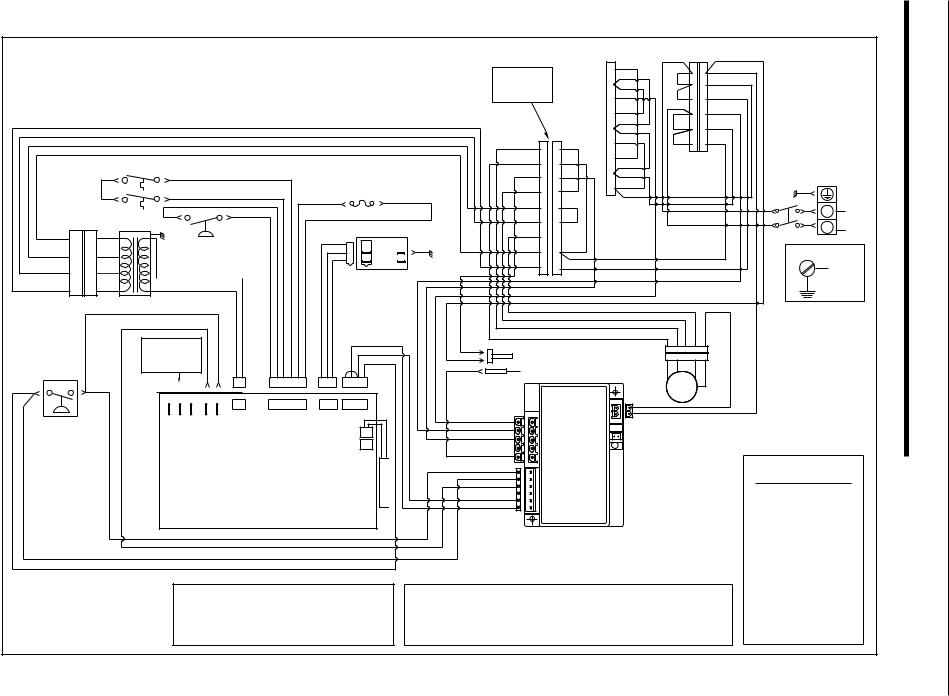
472235 P/N
05-15-4 E .Rev
MiniMax NT TSI & STD W/DDTC Wiring Diagram |
|
|
|
|
|
P12(120V) |
J13 |
P13 |
|
|
|
|
|||||||||
|
|
|
|
|
|
GY |
|
|
|
BR |
|
|
|
|
|||||||
|
|
|
|
|
|
|
|
|
|
|
|
|
W |
|
|
|
|
|
|
||
|
|
|
|
|
|
|
|
NOTE : |
|
|
|
1 |
BK |
|
1 |
1 |
W |
|
|
|
|
|
|
|
|
|
|
|
|
|
|
|
|
|
|
|
|
|
|
||||
|
|
|
|
|
|
|
|
THE HEATER |
|
|
|
W |
|
|
W |
|
|
|
|
||
|
|
|
|
|
|
|
|
|
|
2 |
BK |
2 |
2 |
|
|
|
|
||||
|
|
|
|
|
|
|
|
IS PREWIRED |
|
|
|
|
|
|
|
|
|||||
|
|
|
|
|
|
|
|
|
|
|
BL |
W |
|
|
W |
|
|
|
|
||
|
|
|
|
|
|
|
|
FOR 240 VAC |
|
|
3 |
3 |
3 |
|
|
|
|
||||
|
|
|
|
|
|
|
|
|
|
|
|
4 |
BK |
BK |
|
4 |
BK |
|
|
|
|
|
|
|
|
|
|
|
|
|
|
|
|
|
4 |
|
|
|
|
||||
|
|
|
|
|
|
|
|
|
|
|
|
BK |
|
|
|
|
|
||||
|
|
|
|
|
|
|
|
|
|
|
|
|
BK |
|
|
BK |
|
|
|
|
|
|
|
|
|
|
|
|
|
J12 |
|
P12(240V) |
5 |
BK |
5 |
5 |
|
|
|
|
|||
|
|
|
|
|
|
|
|
|
|
|
|
|
|
|
|||||||
|
|
|
|
|
|
|
|
|
|
|
|
|
|
|
|
|
|
|
|||
|
|
|
|
|
|
|
|
O |
|
1 GY |
6 |
W |
BK |
6 |
6 |
BK |
|
|
|
|
|
|
|
|
|
|
|
|
|
1 |
|
|
|
|
|
|
|
||||||
|
|
|
|
|
|
|
|
|
GY |
|
|
|
|
|
|
|
|
||||
|
HIGH LIMITS |
|
|
|
|
|
PR |
|
2 BK |
7 |
|
|
|
|
|
|
|
|
|||
|
|
|
|
|
|
2 |
BK |
|
|
|
|
|
|
|
|
||||||
|
|
|
|
|
|
|
|
|
|
|
|
TERM |
|
||||||||
|
115˚F |
|
|
|
|
|
BR |
|
|
Y |
8 |
BK |
|
|
|
|
|
|
|||
|
|
R |
|
|
|
|
|
3 |
3 |
|
|
|
|
|
BLOCK |
|
|||||
|
|
|
|
|
|
|
|
|
|
|
W |
|
|
|
|
|
|
||||
|
O |
|
|
|
|
|
|
BK |
4 |
4 |
GY |
9 |
|
|
|
|
G |
|
G |
|
|
|
R |
|
|
THERMAL FUSE |
|
W |
|
|
|
|
|
|
|||||||||
|
|
|
|
Y |
|
|
|
|
|
|
|
|
|
120 VAC |
|||||||
|
|
Y |
|
|
|
|
|
|
|
|
|
|
|
|
|||||||
|
|
|
|
|
|
R/W |
|
5 GY |
|
|
|
|
|
W |
W |
|
|||||
|
150˚F |
PR |
PR |
|
|
|
|
5 |
|
|
|
|
|
N |
W |
OR |
|||||
|
|
|
|
|
BK/W |
|
|
|
|
|
|
|
|
|
|
|
|||||
|
|
|
|
|
6 |
6 GY |
|
|
|
|
|
BK |
BK |
|
240 VAC |
||||||
J15 |
P15 |
|
|
|
|
|
|
|
|
|
|
|
L |
||||||||
|
R |
G |
|
|
|
GAS VALVE |
|
Y |
|
|
|
|
|
|
|
|
|
|
BK |
|
|
R |
|
|
|
|
7 |
7 |
|
|
|
|
|
|
|
|
|
|
|
||||
WATER PRESS |
R |
|
|
|
|
|
|
|
|
|
|
|
|
|
|
|
|||||
|
|
|
|
|
|
|
|
|
|
|
|
|
|
|
|
|
|||||
|
|
|
|
|
|
|
|
|
|
|
|
|
|
|
|
|
|
|
|||
R/W |
R/W |
SWITCH |
|
W |
|
MV |
G |
R |
8 |
8 |
BK |
|
|
|
|
|
|
BOND LOG |
|
|
|
|
|
BL |
|
|
BK |
|
|
|
|
|
|
(ON THE SIDE JACKET) |
|
||||||||
|
|
|
|
MV |
|
BK |
|
|
|
|
|
|
|
|
|
|
|
|
|||
|
|
|
|
|
|
|
9 |
9 |
W |
|
|
|
|
|
|
|
G |
|
|
||
BK/W |
BK/W |
|
|
|
|
|
|
|
|
|
|
|
|
|
|
|
|||||
|
W |
|
|
|
|
|
|
|
|
|
|
|
|
ATTACH |
|
||||||
|
|
|
|
|
|
|
|
|
|
|
|
|
|
|
|
|
|
|
|||
BK |
BK |
|
O |
|
|
|
|
|
|
|
|
|
|
|
|
|
|
|
GROUND |
|
|
|
|
|
|
|
|
|
|
|
|
|
|
|
|
|
|
WIRE HERE |
|
||||
|
|
GY |
|
|
|
|
|
|
|
|
|
|
|
BK |
Y |
|
W |
|
|
|
|
|
|
|
|
|
|
|
|
|
|
|
|
|
|
|
|
|
|
|
|
|
|
|
|
PR |
|
|
|
|
|
|
|
|
|
|
|
O |
|
|
|
|
|
|
|
|
SEE OPERATION |
|
|
|
W |
|
|
|
|
|
|
PR |
|
|
|
|
|
|
|
|
|
|
|
|
|
|
BR |
|
|
|
|
|
|
|
|
J14 |
|
|
|
|
|||
|
& INSTALLATION |
|
|
|
R |
|
|
|
|
|
|
|
|
|
|
|
|
|
|||
|
|
MANUAL FOR |
PR PR R R Y Y |
|
|
O |
BR |
IGNITER |
|
|
|
PR |
O BK |
Y |
W |
P14 |
|
|
|
|
|
|
REMOTE CONTROL |
|
|
BR |
|
|
|
|
|
|
|
|
|
|
|||||||
|
|
|
|
FLAME SENSOR |
|
|
|
|
|
|
|||||||||||
COM NO |
GY |
{ |
|
|
P4 |
P7 |
P10 |
P11 |
|
|
|
BLOWER |
|
|
|
|
|
|
|
|
|
|
J16 |
|
|
||||
O |
J5 |
J8 J6 |
J1 |
J2 |
J4 |
J7 |
JI0 |
J11 |
|
|
W |
|
|
|
O |
|
|
|
|
J17 |
|
F1 |
|
|
|||||
|
|
|
|
|
24V |
TFUSE |
VLV |
IGN |
|
F2 |
W |
|
|
|
|
POOL |
SPA COM |
24VAC |
FAN |
BL |
|
|
|
|
|||||
BLOWER |
|
HLMT |
|
MOD |
IGN/120 |
|
|
|
|
|||||
|
|
BK |
|
|
|
|
||||||||
AIR PRESSURE SW. |
|
|
|
|
|
PRESS |
|
P9 |
L1 |
|
|
|
|
|
|
|
|
|
|
|
Y |
FC |
|
|
|
||||
|
|
|
|
|
|
|
|
|
|
|||||
|
|
|
|
|
|
|
|
|
IGN/240 |
|
|
|
||
|
|
|
|
|
|
|
|
J9 |
|
|
|
|
|
|
|
|
|
|
|
|
|
|
|
L2 |
|
|
|
|
|
|
|
|
|
|
|
|
|
|
BR |
|
|
|
|
|
|
|
|
|
|
|
|
|
|
IGN/FS |
|
|
|
|
|
|
|
|
|
|
|
|
|
THERMISTER |
|
|
|
|
WIRE COLOR |
|
|
|
|
|
|
|
|
|
GY |
VLV |
|
|
|
||
|
|
|
|
|
|
|
|
|
|
|
|
|||
|
|
|
|
|
|
|
|
|
PS |
|
|
(COULEUR DU CABLE) |
||
|
|
|
|
|
|
|
|
|
O |
|
|
|||
|
|
|
|
|
|
|
|
|
TH |
|
|
|||
|
|
|
|
|
|
|
|
|
PR |
24VAC |
|
|
|
|
|
|
|
|
|
|
|
|
|
R |
|
|
|
BK |
: BLACK (NOIR) |
|
|
|
|
|
|
|
|
|
|
|
|
|
|
|
|
|
|
|
|
|
|
|
|
W |
GND |
|
|
BL |
: BLUE (BLEU) |
|
DDTC |
|
|
|
|
|
|
|
|
BR |
: BROWN (MARRON) |
|||
|
|
|
|
|
|
|
|
|
|
|||||
|
|
|
|
|
|
|
|
|
|
|
|
|
G |
: GREEN (VERT) |
|
|
|
|
|
|
|
|
|
|
|
|
|
GY |
: GRAY (GRIS) |
|
|
|
|
|
|
|
|
|
|
|
|
|
O |
: ORANGE (ORANGÉ) |
|
|
|
|
|
|
|
|
|
|
|
|
|
PR |
: PURPLE (VIOLET) |
|
|
|
|
|
|
|
|
|
|
|
|
|
R |
: RED (ROUGE) |
|
|
|
|
|
|
|
|
|
|
|
|
|
Y |
: YELLOW (JAUNE) |
|
|
IF ORIGINAL FACTORY WIRING MUST BE REPLACED, |
SI L'INSTALLATION ELECTRIQUE ORIGINALE D'USINE DOIT ETRE REMPLACEE, |
W |
: WHITE (BLANC) |
|||||||||
|
|
INSTALLER MUST SUPPLY UL/CSA APPROVED WIRE |
L'INSTLLATEUR DOIT PROCURER DES CABLES UL/CSA APPROUVES AVEC |
R/W |
: RED W/WHITE TRACE |
|||||||||
|
|
WITH 18 AWG, 600V, 105˚C TEMP. RATING. |
|
|
18 AWG, 600V, 105 DEGRES CELSIUS D'ECHELLE DE TEMPERATURE. |
|
||||||||
|
|
|
|
|
|
(ROUGE ET/BLANC) |
||||||||
|
|
THERMAL FUSE WIRING MUST BE REPLACED WITH |
L'INSTALLATION ELECTRIQUE DU FUSIBLE THERMIQUE DOIT ETRE REMPLACEE |
BK/W : BLACK W/WHITE TRACE |
||||||||||
|
|
|
(NOIR ET/BLANC) |
|||||||||||
|
|
18 AWG, 600V, 150˚C TEMP. RATING. |
|
|
AVEC UNE ECHELLE DE TEMPERATURE A 18 AWG, 600V, 150 DEGRES CELSIUS. |
|
||||||||
|
|
|
|
|
|
|||||||||
472153D
Figure 19.
WIRING |
.III Section |
NT–DIAGRAM |
Installation |
DDTC WITH TSI & STD |
|
20
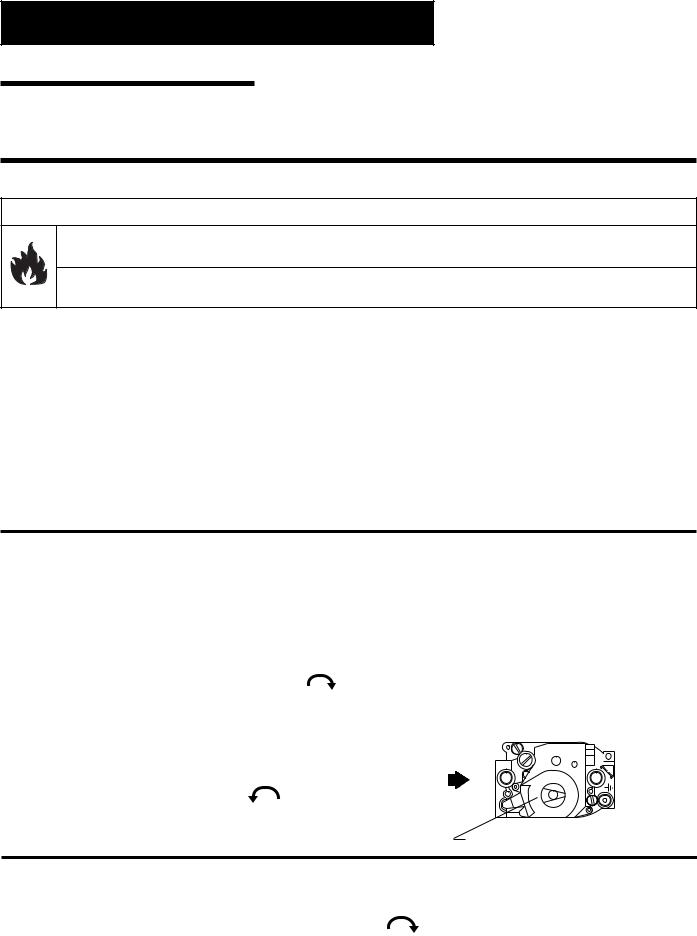
Section IV. Operation |
21 |
Operation Instruction
BASIC SYSTEM OPERATION
1.Start pump, make sure the pump is running and is primed, to close the water pressure switch and supply power to heater. Be sure the pool and/or spa is properly filled with water. Follow the Lighting/Operating instructions below.
MINIMAX NT HSI ELECTRONIC IGNITION LIGHTING/OPERATION
FOR YOUR SAFETY: READ BEFORE LIGHTING
 WARNING
WARNING
If you do not follow these instructions exactly, a fire or explosion may result causing property damage, personal injury or loss of life.
Do not attempt to light the heater if you suspect a gas leak. Lighting the heater can result in a fire or explosion which can cause personal injury, death, and property damage.
A.This appliance does not have a pilot. It is equipped with an ignition device which automatically lights the burners. Do not try to light the burners by hand.
B.BEFORE OPERATING, smell all around the appliance area for gas. Be sure to smell next to the floor because some gas is heavier than air and will settle on the floor.
WHAT TO DO IF YOU SMELL GAS
-Do not try to light any appliance.
-Do not touch any electrical switch; do not use any phone in your building.
-Immediately call your gas supplier from a neighbor's phone. Follow the gas supplier's instructions.
-If you cannot reach your gas supplier, call the Fire Department.
C.Use only your hand to push in or turn the gas control knob. Never use tools. If the knob will not push in or turn by hand, don't try to repair it, call a qualified service technician. Forced or attempted repair may result in a fire or explosion.
D.Do not use this appliance if any part has been under water. Immediately call a qualified service technician to inspect the appliance and to replace any part of the control system and any gas control which has been under water.
OPERATING INSTRUCTIONS
1.STOP! Read the safety information above, (A through D).
2.Open the access doors. Set power switch to ”OFF”, (see Figure 25).
3.Set the thermostat to ”OFF”, (see page 27).
4.This appliance is equipped with an ignition device which automatically lights the burners. Do not try to light the burners by hand.
5.Push in gas control knob slightly and turn clockwise to “OFF”.
NOTE: Knob cannot be turned to “OFF” unless knob is pushed in slightly. Do not force.
6.Wait five (5) minutes to clear out any gas. If you then smell gas, STOP! Follow "B" in the safety information above. If you don't smell gas, go to the next step.
7. Turn gas control knob counterclockwise |
to “ON”. |
See Figure 20. |
|
8.Close the access doors and set the thermostat to desired Mode: “POOL, SPA or REMOTE”.
9.Set the thermostat to the desired temperature setting.
a.Ignition module is energized and the pre-purge cycle is started, approximately 15 seconds.
b.Fan motor starts, which closes Vacuum Air Pressure (fan) switch.
c.Check for powering-up the (glow coil) hot-surface ignitor by viewing through the glass window or opening on the burner face plate.
10.If the appliance will not operate, follow the instructions "To Turn Off Gas To Appliance" and call your service technician or gas supplier.
Gas |
|
Inlet |
ON |
|
OFF |
Figure 20. |
Gas control knob shown in “ON” position. |
|
TO TURN OFF GAS TO APPLIANCE
1.Turn off all electric power to the appliance if service is to be performed.
2.Set the thermostat to “OFF”.
3.Open access doors.
4.Push in gas control knob slightly and turn clockwise to "OFF". Do not force.
5.Close access doors.
Rev. E 4-15-05 |
P/N 472235 |
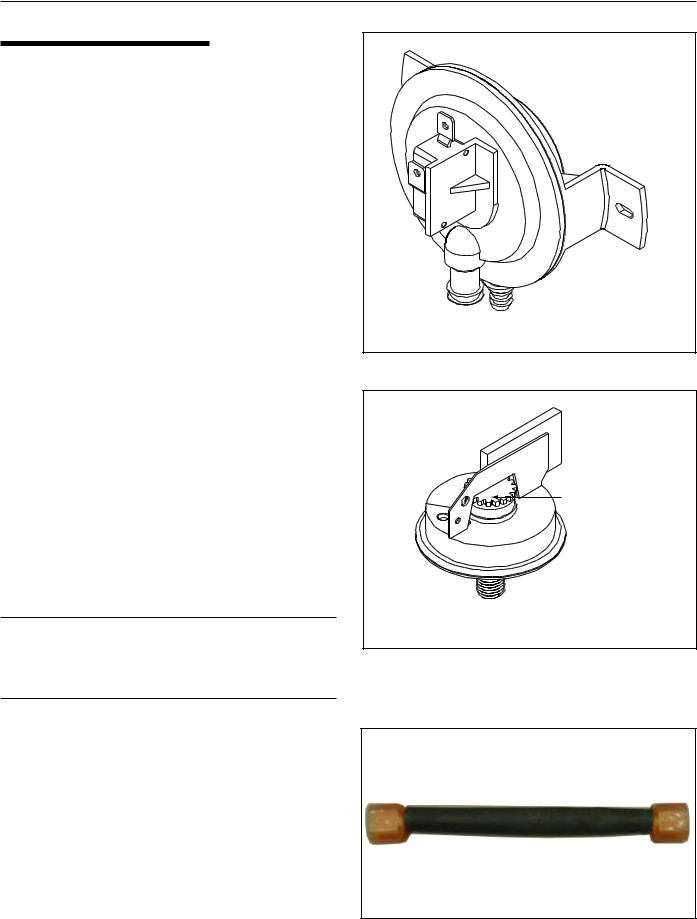
Section IV. Operation |
22 |
SAFETY CONTROLS |
|
|
Figure 21. |
VACUUM AIR PRESSURE (FAN) |
|
SWITCH |
|
The air pressure switch, (see Figure 21), is a safety |
|
device used to insure that the combustion air blower |
|
(fan) is operating and has been designed to monitor |
|
the vacuum (negative) pressure within the blower |
|
housing. The air pressures switch is factory set and is |
|
connected upstream of the ignition module. The |
|
ignition module does not operate unless the air |
|
pressure switch and all safety switches are closed. |
|
|
AIR PRESSURE SWITCH |
WATER PRESSURE SWITCH |
Air Pressure Switch |
|
The water pressure switch, (see Figure 22), closes when there is a sufficient flow of water to the heat exchanger to safely operate the heater. The switch has been preset by the Factory at 1½ PSI for operation.
NOTE: See, Below Pool Level Installation instructions on page 8. The switch may remain closed with no water flow if there is more than a 3 ft. elevation difference between the heater (heat exchanger) and the pool water line—if this is the case, the water pressure switch must be reset by a qualified service technician to maintain open switch contacts with no water flow.
NOTE
If the pool is more than one floor above or one floor below the heater, the water pressure switch may have to be replaced with a flow switch.
Figure 22.
Adjustment Knob
Typical Water Pressure Switch
THERMAL FUSE
This is a single-use switch, mounted on combustion chamber jacket divider (inner front panel). The fuse, (see Figure 23), is activated by excessive temperature due to abnormal operating conditions. Upon detection of excessive heat within the inner front panel, the fuse will open the safety circuit causing shutdown of the heater.
Figure 23.
Thermal Fuse
P/N 472235 |
Rev. E 4-15-05 |
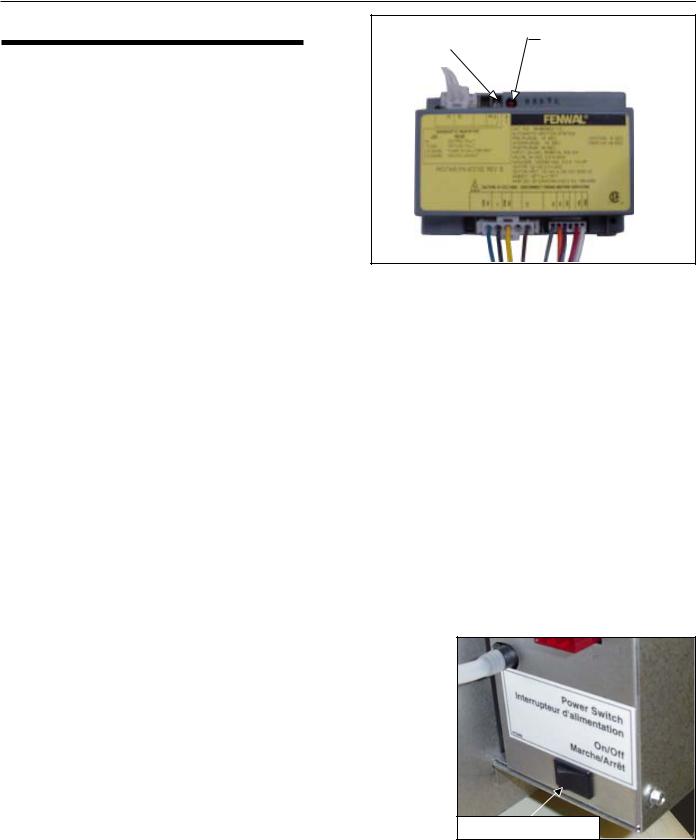
Section IV. Operation
SAFETY CONTROLS, (cont’d.)
Flame Current
Check Point
HIGH LIMITS
A “High Limit”, is a safety device that opens the electrical circuit and shuts off the heater based on a water temperature set point within the “High Limit Device”. The MiniMax NT series of heaters contains two (2) high limit devices which are located on the main inlet / outlet header, one sensing the inlet water temperature and one sensing the outlet water temperature.
OPERATION OF IGNITION MODULE
The Ignition Module, (see Figure 24), is microprocessor based and operates on 24 VAC supplied by the transformer. The control utilizes a microprocessor to continually and safely
monitor, analyze, and control the proper operation of the gas burners. The module with the presence of the flame sensor, using flame rectification, allows the heater to operate.
1. HEAT MODE
•When a call for heat is received from the thermostat supplying 24 volts to the (TH) terminal, the module will check the pressure switch for normally open contact. The combustion blower is then energized and, once the air pressure switch contacts close, the 15-second "pre-purge" period begins. After pre-purge, the hot surface igniter is energized for approximately 40-second heat-up period, followed by the gas valve for the "trial for ignition" (TFI) period, for maximum of 7 seconds for the STD model and 6 seconds for the TSI model.
•When the flame is detected during the TFI period, through the flame sensor, the igniter is deactivated and the gas valve remains energized.
Note: For all TSI heaters: After the pre-purge period the combustion blower slows down to half normal speed during the heat-up and TFI periods and continues thereafter for another 30 seconds at low speed, then return to full speed for the remainder of the heating cycle.
•The thermostat, air pressure switch and burner flame are constantly monitored to assure that the system operates properly. When the thermostat is satisfied and the demand for heat ends, the gas valve is immediately de-energized, the module senses the loss of flame signal and initiates the 45-second "post-purge" period before de-energizing the combustion blower.
2. FAILURE TO LIGHT THE BURNER—LOCK OUT
Should the main burner fail to light, or the flame is not detected during the first TFI (try for ignition) cycle, the gas valve is de-energized and the ignition module performs an "inter-purge" delay (approximately 15 seconds) before attempting another TFI cycle. The module will attempt 2 additional TFI's cycles before locking out. The gas valve will be turned off immediately. The combustion blower will be turned off following 45 seconds "post-purge" period.
The module will automatically reset after one hour, if the thermostat is still calling for heat, and attempt a new TFI cycle.
INTERNAL POWER SWITCH
3. FLAME FAILURE—RE-IGNITION
If the established flame signal is lost while the burner is operating, the control will respond within .08 second. The gas valve is de-energized and the control
starts a new ignition sequence in an attempt to relight the burner. The ignition attempt will be repeated (3) times. If the burner does not relight, the control will go into lockout as previously described in the “Failure to Light the Burner—Lock Out”. If flame is reestablished, normal operation resumes.
Rev. E 4-15-05 |
P/N 472235 |
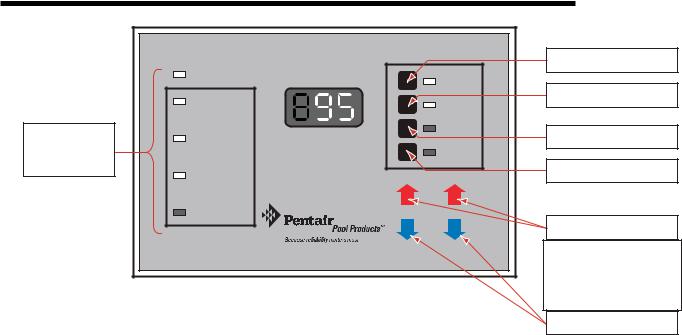
Section IV. Operation |
24 |
|
|
DIGITAL DISPLAY TEMPERATURE CONTROLLER (DDTC)
|
|
|
REMOTE BUTTON |
|
POWER |
|
REMOTE |
|
|
|
|
|
PRESSURE SW |
|
POOL BUTTON |
|
|
POOL |
|
|
|
|
|
SYSTEM |
|
|
SPA |
THERMOSTAT |
|
SPA BUTTON |
|
INDICATOR |
|
|
OFF |
LIGHTS |
|
|
OFF BUTTON |
|
HEATING |
|
|
|
TEMPERATURE SETTING |
||
|
SERVICE |
POOL |
SPA |
|
|
|
TEMP. UP |
|
|
PRESS ANY ARROW ONCE TO |
|
|
|
CHECK SET TEMPERATURE |
|
|
|
|
SPA AND POOL |
|
|
|
TEMPERATURE |
|
Figure 26. |
|
SET BUTTONS |
|
|
|
|
|
|
|
TEMP. DOWN |
The DDTC board, shown in Figure 26, is a digital temperature controller capable of controlling the pool, spa or both to a minimum temperature of 65° F. (below 65° F. display reads "Off") and a maximum of 104° F. The DDTC board also functions as a system status indicator, using LED lights and programmed error codes.
During normal operation, the DDTC will display the current temperature of the water returning to the heater, depending on which mode has been selected, “Pool” or “Spa”. This is accomplished by a thermister (sensor) on the inlet port of the water header of the heater and working in conjunction with the internal microprocessor controlling the operation of the heater.
Changing the desired pool or spa temperature is easily done by simply depressing the appropriate up or down arrow until the display reads the desired set-point temperature. For example, set pool to 78° F. and the spa to 104° F., when releasing the up or down arrow the display will flash once then return to the current temperature.
At any time, you wish to know the temperature setting of the pool or spa, simply press the appropriate up or down arrow, the display will flash once and display the set-point temperature for three (3) seconds, then flash once again and return to the current temperature.
P/N 472235 |
Rev. E 4-15-05 |
